
We haven't stepped into the Twilight Zone, but it certainly seems that way when stocks are hitting historic highs yet the economy is still so weak that the Federal Reserve is printing money like a Third World nation.
It has the makings of a great prize fight between the largest market in the world and the largest economy in the world.
Can we keep this up? Is this titanic battle going to last like the decades-long Japanese recovery? Will stocks punch themselves out? Can slowing earnings keep stocks soaring?
Creating Value in the Stock Market
Let's address one of the most fundamental inputs in this situation: stock prices. Company valuations and their stock prices are a function of several inputs; the most important of which are earnings growth expectations and dividends.
One way to look at the price of a stock is to look at the present value of the expected future stream of dividends the company is supposed to pay out. In other words, when you get income from this company in the future, what's that worth to you now?
You don't have to apply any modeling to get to your valuation; the market basically does that for you by arriving at a consensus price that incorporates the discount model math.
Most companies that pay solid, steady dividends don't see their stock price fluctuate too much because they are yield-based investments more than go-go growth investments.
Prices of high-yielding stocks have risen and been strong because investors starved for yield in the fixed income markets have turned to these equities for the income they deliver. And growth investors that were burned in the 2008 meltdown have sought out yields for safety and steady growth.
"I subscribe to a number of investment adivsories. This is by far the best letter that I have seen." – Dennis Gibbs, Connecticut |
||
That's making income investments very popular across all investor classes.
Dividends come out of earnings, so earnings are important. But for stocks that don't pay a dividend, earnings (or in the case of crazy Internet-type stocks, would-be earnings) are everything.
Earnings: Good News vs. Bad News
Steady-state earnings don't do much for stock prices. Earnings growth is the Holy Grail. The good news is that stock prices have been rising, justifiably, on better and better earnings.
The bad news is, those earnings, upon a deeper look, aren't sustainable if economic growth doesn't pick up.
Since 2009, earnings on stocks in the S&P 500 have risen collectively some 200%.
Most of those higher net earnings have resulted from cost-cutting, layoffs, productivity increases, favorable tax carry-forwards, refinancing old debt with cheaper low-interest loans, a weak dollar, and accounting gymnastics.
The bad news is over the same period top-line revenues have grown only about 10%.
In other words, in spite of deathly slow domestic growth in the U.S. and slow global growth, American corporations have benefited by leaning themselves out, globalizing their sales to where the growth is, and enjoying a positive currency translation when they account for overseas earnings in terms of cheap dollars.
Love this special report? Hate it? We want to hear from you! Tell us what you think of this report and what you'd like to see on Investors Alley in the future. Click here to email us your comments and feedback. |
||
Central Bank Steroids
Besides inherent valuation measures, stocks are subject to supply and demand equations. If there are more buyers than sellers on any given day, stock prices will rise.
The Federal Reserve and central banks around the world have been providing an extraordinary amount of buying power to short-term investors by flooding banking systems with trillions of dollars, as well as keeping interest rates at rock bottom levels, which adds to investor buying power.
All the stimulus money floating around the world means there's plenty of money to buy stocks, especially for financial institutions. And when there are more buyers than sellers, stock prices, and this has been happening worldwide, will rise.
So far that's all been well and good. GDP growth hasn't had to be the prime mover of stocks. Inherent factors and superficial stimulus have provided the market's fuel.
But, without strong economic growth, sooner or later, demand alone will prove inadequate in supplying top-line revenue and net earnings growth and stocks could fall.
The Reckoning
The market, which can still be saved hopefully long enough for GDP growth to kick in, and if sidelined investors keep pumping money into new positions, is nonetheless facing another headwind.
Share ownership and investor participation is dwindling in the U.S. as a stagnant economy is reducing the middle-class and their ability to invest in stocks.
According to Federal Reserve data from 2010, while 47.8% of the top 10% of income earning households in America owned stocks directly and 90.1% had retirement accounts averaging $277,000, in middle-income (the 40-60 percentile) households only 11.7% owned stocks directly and 52% had retirement accounts worth an average of only $22,800.
"Great advice! Finally someone who helps people without either a long newsletter with no real advice or a really long video where they ask for a lot of money. You are the best and I am recommending you to others!" – James Burston |
||
That's worrisome for the middle-class, the stock market and America.
Entering the 12th Round
The Great Discrepancy has been bridged so far. But, if U.S. domestic growth continues to be lackluster and global growth, which is already slowing, doesn't pick up robustly it's unlikely that soaring stocks can keep fighting against what looks like a rope-a-dope opponent.
Is the fight over? By no means. GDP growth can pick up if housing continues to recover, if energy prices keep falling, if manufacturing jobs get repatriated back here, if the Fed stays its easy money course long enough for growth to get to its knees, stand up and start swinging.
Then again, I watched the famous Muhammad Ali-George Foreman fight where Ali took a beating on the ropes from a wildly punching Foreman, until Foreman ran out of gas and Ali outlasted the opponent he called a dope.
That means, don't be a dope. Ride the rising market but use protective stops to take profits on the way up so you have a sack full of money to buy from the dopes who've forgotten that what goes up, must come down, when the big market hits the canvas.
Another Troubling Fact: Margin Buying Surpasses 2007 Danger Levels
There's nothing like buying securities with money you don't have - or, more precisely, with borrowed money from your broker, with your investments as collateral.
It's called buying on margin, and it's soaring as the market continues its tear and speculative investors seek a piece of the action. As your stocks appreciate you can borrow even more. A market rally lets you expand your portfolio by piling on more debt.
But it's potentially dangerous and could portend a stock market crash.
As the accompanying chart shows, historically there has been a direct link between a surge in margin loans and corresponding stock market peaks - followed by sharp declines in the markets.
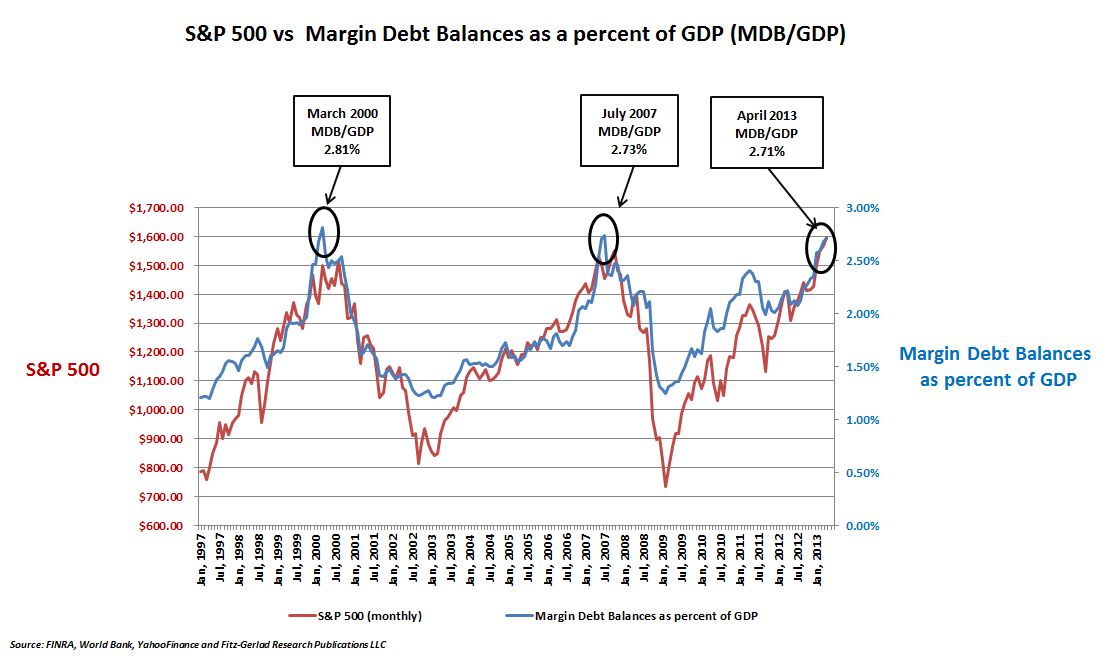
So it's no small matter of concern that the Financial Industry Regulatory Authority reports the amount owed on loans secured by investments climbed to a record high $384 billion at the end of April.
That topped the previous high - $381 billion in 2007, not coincidentally, just before the financial meltdown and the Great Recession.
As a percentage of the economy, the latest margin borrowing totaled 2.71% of gross domestic product.
By comparison, margin borrowing hit 2.73% of GDP in July 2007, during the housing bubble, and 2.81% in March 2000 during the tech bubble, which was followed by a stock market crash.
"Very Much a Danger Sign"
So how should investors view the latest figures on margin borrowing?
"They're very much a danger sign," Money Morning Chief Investment Strategist Keith Fitz-Gerald said. "From a technical perspective, margin borrowing has risen to levels that we know are consistent with major corrections."
But Fitz-Gerald pointed out, "Investors need to learn to review the figures just like a big road sign. It doesn't stop you from driving down the road. It just says 'potential hazard ahead.'"
In margin lending, investors who take out margin loans get cash from their broker, with their investments as collateral, and can use the cash to pay for other investments.
Brokers set a minimum value of equities an investor must keep in an account, and if the account dips below this level as stocks depreciate they can issue a margin call requiring the investor to put more money into their account - or force them to sell securities to cover the margin.
"Great articles that are to the point. I am dropping most other newsletters, but Investors Alley will most certainly remain." – Guy Caiazzo, Maryland |
||
"The problem with margin is that it magnifies the risks you take," Fitz-Gerald said. "Your profit potential is huge but then so is your loss potential unless you know how to manage that risk properly.
"Most retail investors simply do not understand what it is they're getting into and they fall prey to these very seductive investment ads coming out of Wall Street that are designed for one purpose and one purpose only: to separate them from their money."
Depression-Era Margin Calls
Today, an investor's minimum margin requirement - set by the Federal Reserve - is 50%, much higher than margins that had been as low as 10% during the 1920s. This means today you can buy $10,000 of stock by borrowing $5,000 from your broker on margin.
Back then, when the market started to contract and investors got margin calls they couldn't cover, their shares were sold, leading to more market declines and more margin calls.
This phenomenon was a major contributor to the 1929 market crash and the Great Depression, Fitz-Gerald noted.
"Investors started taking assets that they needed and they started leveraging them into investments that they arguably didn't need," he said, "and when we had the big crash, people found out the hard way that it's awfully hard to pay back loans you have with assets that depreciate in value."
Magazine Covers: Stock Market Crash Indicator?
If you're contrarian, then Barron's latest "Big Money" poll and its magazine cover just gave you reasons to be on the lookout for a stock market crash.
"So nice to read straight forward recommendations without obsification (never really telling the name). You are one of my top reads." – Gene Uhler, Colorado |
||
The semiannual poll of professional investors found that 74% of money managers are bullish or very bullish about the prospects for U.S. stocks - an all-time high for Big Money, going back more than 20 years.
Barron's drives the point home with its over-the-top cover titled "Dow 16,000!"
But not everyone feels as confident as these polled investors - especially since the issue follows 2013's worst weekly performance for stocks.
"Rule o' Thumb: When the cover of a major financial magazine features a cartoon of a bull leaping through the air on a pogo stick, it's probably about time to cash in the chips," mutual fund owner John Hussman wrote on his Hussman Funds website.
Dow 16,000, or a Stock Market Crash?
In its more than 20-year history, Barron's Big Money poll has a history of making overly bullish calls at precisely the wrong time.
"Still Bullish! (Dow 13,000)" was published May 1, 2000, with the Dow Jones Industrial Average at 10,733.91. The Dow had already fallen almost 1,000 points from its high in January 2000 and would go on to lose about 40% of its value in the 2000-2002 bear market. The S&P 500 and the Nasdaq performed much worse.
"Dow 14,000?" was published in Barron's May 2, 2007, with the Dow at 13,264.62. The Dow did actually hit 14,000 by October 2007.
In that year's second Big Money poll, released in November, the headline read, "The Party's Not Over," and bulls outnumbered bears 2-to-1.
But as we know, the market had already peaked and would go on to lose over half its value in the 2007-2009 bear market.
This graphic from Hussman sums up the "Barron's Cover Jinx:"

Think of this as the investing equivalent of the "Madden Curse," in which the NFL player on the cover of the Madden video game every year suffers a serious injury or dramatically underperforms.
Hussman's not the only market analyst who likes to use magazine covers as potential contrarian indicators.
Money Morning Chief Investment Strategist Keith Fitz-Gerald pointed out last year, "Magazine covers help me to latch on to important market shifts and trends that others either miss or simply don't see coming."
Looking at these bold headline predictions from the past helps you see why.
"The Death of Equities" adorned the cover of Business Week's Aug. 13, 1979 edition - and the headline could hardly have been more wrong.
The Dow shot up 1,153.76% over the next 20 years. The S&P 500 tacked on 1,135.97% and the tech-heavy Nasdaq rose 1,705.9% over the same time period. The investors who went to the sidelines got left behind.
Then in 1999, Time magazine named Amazon CEO Jeff Bezos "Man of The Year."
Within 24 months, the Internet bubble had burst and shares of Amazon (Nasdaq: AMZN) closed below $6, shedding 94.32% from a previous high of $105.06.
In 2003, after the price of a barrel of oil had fallen to between $20 and $30 a barrel, The Economist ran the headline "The End of the Oil Age."
You guessed it: Oil took off on a triple-digit run, finally peaking in 2008 at $141.71 a barrel.
While investors shouldn't base decisions purely on magazine headlines, they do help give a sense of when markets may be too euphoric or fearful.
History has shown us that much.
Stock Market Crash Protection for Your Portfolio
Thanks to billions of dollars in quantitative easing from the U.S. Federal Reserve, fears over a looming stock market crash have been put on hold lately.
The Standard & Poor's 500 Index is up 15% this year. The market's outstanding performance has shrugged off weak earnings reports, slowing growth in China, and continued weakness in Europe.
It seems that zero interest rates really do trump all. Even Warren Buffett is unsure how all this ends, telling shareholders at the Berkshire Hathaway (NYSE: BRK.A, BRK.B) annual meeting "it's really uncharted territory. It's a lot easier to buy things sometimes than it is to sell them."
Short Term TradingHere are five things you should look for on the DAILY charts to help you understand when a stock or index chart is bottoming near term:
As many of these things that you can get to come together on the daily charts is when you want to buy, even though it won't feel good to buy there. Clearly there's more to buying or selling than this, but this is what I can teach you online without doing an entire seminar. There's so much more but if you follow these simple rules your trading should improve quite a bit. |
||
And I recently heard legendary real estate investors who at a conference compared the market to a game of musical chairs where everyone keeps playing because the music - QE - is still going.
But they cautioned that investors who aren't careful will be quickly left without a seat.
That's why investors should take steps to protect their portfolio from a possible severe decline in prices. Whether it's a stock market crash or a more mild price pullback, you always want to make sure you're prepared.
It's time to sit down and go through your holdings stock by stock and ask some key questions:
- Is the reason you bought the stock still true?
- Do you have stocks that have experienced strong gains and now sell at very high valuation based on earnings, sales, and asset value?
- Has the company's business or financial position changed for the worse since you bought the shares?
- Would you buy the stock again today at the current price?
This type of prudent pruning can help you accomplish two things that will help protect you against losses from a market crash or sell off.
First, getting rid of overvalued stocks and underperforming companies will reduce your overall exposure to the market. Increasing your cash holdings may lower your return in the short term, but cash does not decline in a sell off.
It also gives you dry powder in your arsenal that can be used to scoop up bargain issues after a steep decline.
If you want more protection than pruning provides, you can buy insurance against the decline; here's one way to do that...
Using put options on the S&P 500 Spyder Exchange Traded Fund (NYSE: SPY) gives you "stock market crash insurance." You can even pick your own deductible based on how much risk you feel you can endure.
If you are worried about a decline in the market of more than 10% or so, you can buy a put option at $150 on the SPY that expires in January 2014. Each contract will cost you about $378 or about 2% of face value. If the SPY falls below 150, the puts will rise in value protecting you against steep losses.
Each contract represents roughly $16,000 of market value right now so you will need seven contracts for every $100,000 of portfolio value for full protection. If you want a longer term insurance policy, you can buy the same option for about $676, or 4.5% of face value that expires next June.
If you prefer more protection, you can protect against a loss of greater than 5% by purchasing options with a strike price of $157. This will cost about $550 for each January contract.
Just like all insurance policies you buy, the more protection you want, the higher premiums you pay for coverage. If the stock market falls you will enjoy the offsetting gains in the put options to keep your portfolio value relatively steady.
Of course if it does not, you lose the premiums paid just as you do with auto or homeowners insurance.
Danger Ahead: Sell (or Short) These Stocks
There are events unfolding right now that show you need to know how to invest in a market correction...
First, this bull market - the most unloved bull market in history - has continued for 54 months now. That's a full 11 months longer than the average bull market run since 1953.
Second, the forces keeping this bull market going are almost completely divorced from any economic reality.
Unemployment and underemployment - the sheer number of Americans who've flat out given up looking for work - remains appallingly high, at 14%. Economic growth, limping in at under 2% per year, is anemic.
Yet, the markets have surged for more than four and a half years... hitting as high as 15,628... shattering all records as they go.
Now market crash indicators like the Hindenburg Omen are alerting investors to prepare now. And the rising yield on 10-year Treasuries could trigger a selloff.
But a market correction, crash, or downturn is nothing to fear if you know how to invest for that scenario. A good investor is prepared to stay in - and make money in - any market.
In fact, the only sure way not to make money is to be out of the market.
So, here's where to start.
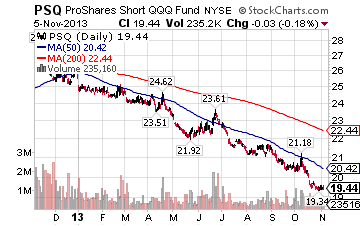 How to Invest When Markets Fall
How to Invest When Markets Fall
Inverse exchange-traded funds (ETFs) can be a powerful hedge against a downturn or crash. Even more than a hedge, they can be a tool to make money while everyone else is losing theirs.
Bearish investors nowadays have a truly staggering array of short plays to make using ETFs. If you can think of it, there's an inverse ETF to short it: commodities, market cap ranges, precious metals, indexes, entire sectors, whole national economies, currencies - nearly anything.
 Inverse ETFs can be a bit more expensive than "traditional" ETFs, but they allow investors easy access to the short game, without the hassle and expense of maintaining a margin account.
Inverse ETFs can be a bit more expensive than "traditional" ETFs, but they allow investors easy access to the short game, without the hassle and expense of maintaining a margin account.
If you're expecting any of the major indexes to go through a correction, you would naturally target an inverse ETF. You can always use an ETF that returns a one-to-one inverse of the daily return of whatever you fancy:
 ProShares Short QQQ (ETF) (NYSE Arca: PSQ) will return the daily inverse of the Nasdaq.
ProShares Short QQQ (ETF) (NYSE Arca: PSQ) will return the daily inverse of the Nasdaq.
ProShares Short Dow30 (ETF) (NYSE Arca: DOG) returns the daily inverse of the Dow Jones Industrial Average.
ProShares Short S&P500 (ETF) (NYSE Arca: SH) returns the daily inverse of the S&P 500.
For more aggressive investors, or those with a higher risk tolerance, the UltraShort and UltraPro class of ETFs can provide multiples of the inverse of the Dow Jones Industrial Average, the Nasdaq, the S&P 500, and even the Russell 2000. (Word of warning - those considering leveraged ETFs would do well to remember that multiplied gains can turn quickly into multiplied losses.)
 The ProShares UltraShort S&P500 (ETF) (NYSE Arca: SDS) is perhaps the largest inverse ETF in existence, with $2 billion in assets. It's also the best-selling inverse product of 2013, with $1.1 billion in inflows this year. SDS is geared to provide 200% of the inverse daily return of the S&P 500 (before fees and expenses).
The ProShares UltraShort S&P500 (ETF) (NYSE Arca: SDS) is perhaps the largest inverse ETF in existence, with $2 billion in assets. It's also the best-selling inverse product of 2013, with $1.1 billion in inflows this year. SDS is geared to provide 200% of the inverse daily return of the S&P 500 (before fees and expenses).
You'll be in good company among the other bears in the woods. ProFund Group's alternative ETF unit, ProShares, is one of the country's largest alternative ETF managers.
ProShares has reported inflows of around $3.8 billion into inverse products, so far, in 2013.
A Whole Wide World of Shorts
Far from just indexes, investors can take short bets on a variety of currencies with inverse currency ETFs. Although costs for these tend to be higher than index ETFs, the rewards can be just as nice, and there's nigh unlimited opportunity for speculation.
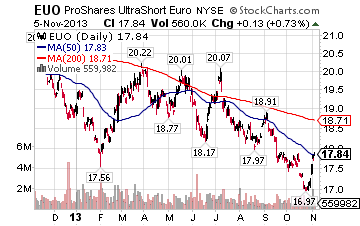 Technology, basic materials, consumer goods, real estate, even semiconductors are available for one-stop short selling. Wherever your bearish sentiment may lead, ProShares offers an ETF to short - with varying liquidity, assets under management, and costs, of course.
Technology, basic materials, consumer goods, real estate, even semiconductors are available for one-stop short selling. Wherever your bearish sentiment may lead, ProShares offers an ETF to short - with varying liquidity, assets under management, and costs, of course.
For instance, if you believe that the euro will decline relative to the dollar, you want to take a position in ProShares UltraShort Euro (ETF) (NYSE Arca: EUO). This will return twice the inverse of the daily decline of the euro to the dollar.
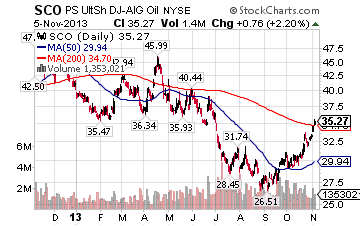 Or if you have a notion that oil might tank, but don't know the best way to parlay those depressed prices into gains, you can buy ProShares UltraShort DJ-UBS Crude Oil ETF (NYSE Arca: SCO). This is one of the most popular inverse oil ETFs around, albeit with higher costs than most inverse index ETFs. It gives twice the inverse daily performance of West Texas Intermediate (WTI) crude.
Or if you have a notion that oil might tank, but don't know the best way to parlay those depressed prices into gains, you can buy ProShares UltraShort DJ-UBS Crude Oil ETF (NYSE Arca: SCO). This is one of the most popular inverse oil ETFs around, albeit with higher costs than most inverse index ETFs. It gives twice the inverse daily performance of West Texas Intermediate (WTI) crude.
If you feel a correction or a crash is in the offing, you could play that for profit by shorting the entire financial sector. The ProShares UltraShort Financials (ETF) (NYSE Arca: SKF) will return twice the inverse of the daily Dow Jones financials sector.
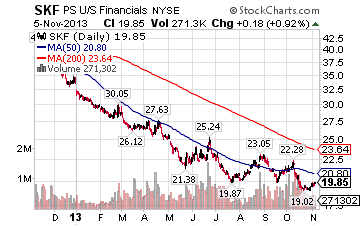 Warning to the Down-Market Profit Hunter
Warning to the Down-Market Profit Hunter
Before you get into trading inverse ETFs to invest in a market correction, there are some important things to consider...
It's very important to note the use of the word daily in relation to the inverse index ETFs. That's a crucial caveat.
It means these are by no means buy-and-hold investments, and treating them that way is dangerous. It's not wise to let these simply "ride out" a market downturn or crash, because your holdings of inverse ETFs can take a hit on a rally, no matter how brief.
As we've reported before, one must always remain vigilant and attuned to their portfolio performance to succeed, and this rule of thumb definitely applies to inverse ETF speculation.
These are better thought of as trading vehicles or tactical tools. You'll need to make continual adjustments to your position should a trend emerge.
That being said, if you want more on how to invest in a market correction, ETFs are just one way that you can have your fill of short plays - and make a killing while all others are being killed.
More Than One Path to Post-Crash Riches
There's also the Chicago Board of Options Exchange Volatility Index (VIX). Some call it the Fear Index, and it's held to be the best gauge of volatility around. In fact, it may be one of the best contrarian indicators in the world.
When volatility takes hold and drives down the price of options on the S&P 500, the Fear Index almost always enjoys a healthy bump. During the recent broad market downturn, the VIX saw some powerful, historic upward surges. For instance, August 21, 2013, saw the VIX jump by 6.91%. And for nearly all of this August, money has been pouring into call options on the VIX to the point where open interest has peaked to its third-highest volume in history.
Avoid These Stocks At All Costs
Speaking of ETFs, prudent investors will best avoid any exposure to real estate investment trusts (REITs), and mortgage REITs in particular.
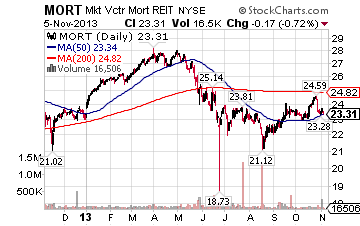 The Market Vectors Mortgage REIT ETF (MORT) is down 24% in less than five months. And a number of its components are down more than 30%.
The Market Vectors Mortgage REIT ETF (MORT) is down 24% in less than five months. And a number of its components are down more than 30%.
But it's going to get worse. A lot worse. And that's why I'm issuing a warning, because practically every "properly diversified" portfolio in America cashes these REIT checks.
Many people depend on them.
This is dangerous, especially when two of the most widely held mortgage REITs also happen to be two of the worst.
To be sure, aside from the one (big) exception you'll see today, a longtime high-yield darling is about to get crushed...
The REIT Spoiler
You can pin this one on the U.S. Federal Reserve, too...
Thanks largely to its pernicious tinkering of monetary policy - first via artificially low interest rates and then via direct injection of capital into the financial system to the tune of $85 billion per month of direct bond buying ($45 billion specifically spent on mortgage-backed securities) - the Fed has created an environment in which interest rates are destined to rise.
In fact, the mere mention by Ben Bernanke back in May that the Fed will soon "taper" its bond-buying program now has caused interest rates, as measured by the benchmark 10-year Treasury Note, to rise to their highest levels in more than two years.
With the biggest buyer moving out of the market, MBSs are sure to take a hit. Moreover, the pace of rate increase has been anything but subtle, with the 10-year yield spiking to 2.90% - a 40% jump in three months.
Because mortgage REITs generate income by essentially borrowing money at short-term rates and then investing in higher-yielding MBSs, any significant increase in the cost of borrowing can devastate mortgage REIT book value.
And they're about to lose their safety net...
As the Fed has basically, and repeatedly, told the markets that tapering is a fait accompli, it means that the buyer of last resort for MBS is about to remove - or at least slowly pull back - the MBS safety net.
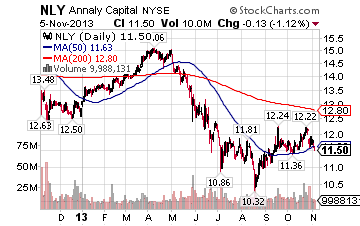 Adding more uncertainty to the mortgage REIT equation is so-called "agency risk."
Adding more uncertainty to the mortgage REIT equation is so-called "agency risk."
The current debate over the fate of mortgage-related agencies Fannie Mae and Freddie Mac, and the future limited role these embattled agencies could play in the MBS space, also has caused the smart money to jettison mortgage REITs.
Two of the worst mortgage REITs to own right now also happen to be two of the most widely held ones, and they are Annaly Capital Management Inc (NYSE: NLY-C) and Two Harbors Investment Corp. (NYSE: TWO).
 In the case of Annaly, the fund invests primarily in MBSs guaranteed by Fannie and Freddie, so it's little wonder why the exodus from this fund has sent NLY cascading some 25% over the past three months. As for Two Harbors, the spin-off of its equity-REIT Silver Bay Realty operations in May turned it into much more of a conventional MBS play. The market saw this, got spooked, and the result was a 20% smackdown over the last three months.
In the case of Annaly, the fund invests primarily in MBSs guaranteed by Fannie and Freddie, so it's little wonder why the exodus from this fund has sent NLY cascading some 25% over the past three months. As for Two Harbors, the spin-off of its equity-REIT Silver Bay Realty operations in May turned it into much more of a conventional MBS play. The market saw this, got spooked, and the result was a 20% smackdown over the last three months.
So, are there any REITs that still are okay to own these days? The short answer is yes...
The REIT Exception: Safe and "Substantial" Income
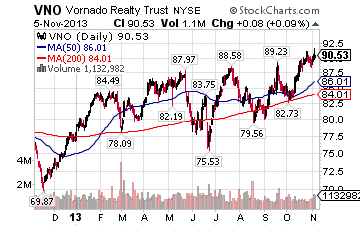 Vornado Realty Trust (NYSE: VNO) is a traditional REIT.
Vornado Realty Trust (NYSE: VNO) is a traditional REIT.
Unlike mortgage REITs, Vornado actually invests directly in prime real estate properties such as office buildings, and the rents from these properties are what Vornado uses to generate income for unitholders.
That income is substantial, as the company owns buildings in the best, highest-rent locations around the country, including economically vibrant New York City, San Francisco, and Washington, D.C.
Vornado doesn't pay 10%-plus on your principal, of course, like NLY and TWO. It gives you something much more powerful: the ability to keep your principal, just in case you ever want your money back.
How to Identify Other Stocks to Sell
Sometimes it's easy to mislabel fantastic companies as great stocks to buy, but the two attributes don't always go hand in hand.
That's because sometimes these great companies watch their share prices climb faster than the underlying fundamentals.
This is often the case with companies/brands that are a big hit with consumers, like Lululemon Athletica Inc. (Nasdaq: LULU) and Chipotle Mexican Grill Inc. (NYSE: CMG).
Since these companies are overpriced, they are usually most vulnerable to a market correction.
Investors should sweep their portfolios now to make sure they aren't holding any of these "high-risk" stocks.
To identify them, investors should look at the price/earnings ratio and price/earnings/growth ratio of the companies they hold.
High P/E and P/E/G ratios often indicate companies whose share prices have been bid up to a point that is no longer justified by fundamentals. The companies themselves might be good investments, but not at the current share price.
Sell These 5 Overvalued Companies
Here are five companies that fall into this category right now:
 Boston Beer Co. Inc. (NYSE: SAM) - This is a fantastic company that brews craft beers and has done a great job of creating and marketing new products to complement its core Sam Adams lager product. The stock is up more than 50% in the past year and has risen eight-fold since the 2009 lows.
Boston Beer Co. Inc. (NYSE: SAM) - This is a fantastic company that brews craft beers and has done a great job of creating and marketing new products to complement its core Sam Adams lager product. The stock is up more than 50% in the past year and has risen eight-fold since the 2009 lows.
All of this appears to be more than priced into the stock with a price to earnings multiple of 36. Sales growth is slowing and earnings for the fourth quarter and full year of 2012 were slightly less than 2011. The PEG ratio now stands at 1.89, a level that many market observers consider to indicate overvaluation based on earnings. Insiders appear to be wary of the stocks prospects as officers and directors have been consistent sellers of the stock since November.
Should the market correct this stock could experience a meaningful decline.
 Under Armour Inc. (NYSE: UA) - Any investor concerned about market risk should avoid this popular athletic apparel company. This is a fantastic company with great products but the truth is the shares are too highly valued for the current economic environment.
Under Armour Inc. (NYSE: UA) - Any investor concerned about market risk should avoid this popular athletic apparel company. This is a fantastic company with great products but the truth is the shares are too highly valued for the current economic environment.
The stock has advanced over the past several years where the valuation does not appear to be sustainable. The stock is up five-fold since the 2009 bottom, but this year investors are already becoming concerned about the steep earnings multiple of the stock. Under Armour trades at more than 40-times current earnings and has a PEG ratio of 2 at the current price.
Given the high multiples and developing price weakness this stock could easily become a casualty in a sell off or correction in the stock market.
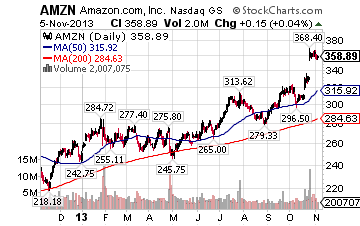 Amazon.com Inc. (Nasdaq: AMZN) - At $270 Amazon has a P/E ratio of 3,375, making it technically the most overvalued stock on the list. Amazon is up 43.6% from a year ago and last week it reached its all-time high of $284. That price could be the peak for AMZN stock as the company's low-cost advantages are starting to decline.
New tax laws in Pennsylvania, Texas and California are now requiring Amazon to start collecting a sales tax from its customers, and more cash-deprived states should follow in that trend. Higher energy costs could cause Amazon to charge more for shipping, further angering customers. Amazon is also facing stiffer online competition from retailers such as Wal-Mart and Target. And some retailers, including Target, are matching or beating the price of Amazon products in its stores. These factors should help bring the company's P/E, and stock, down to realistic levels.
Amazon.com Inc. (Nasdaq: AMZN) - At $270 Amazon has a P/E ratio of 3,375, making it technically the most overvalued stock on the list. Amazon is up 43.6% from a year ago and last week it reached its all-time high of $284. That price could be the peak for AMZN stock as the company's low-cost advantages are starting to decline.
New tax laws in Pennsylvania, Texas and California are now requiring Amazon to start collecting a sales tax from its customers, and more cash-deprived states should follow in that trend. Higher energy costs could cause Amazon to charge more for shipping, further angering customers. Amazon is also facing stiffer online competition from retailers such as Wal-Mart and Target. And some retailers, including Target, are matching or beating the price of Amazon products in its stores. These factors should help bring the company's P/E, and stock, down to realistic levels.
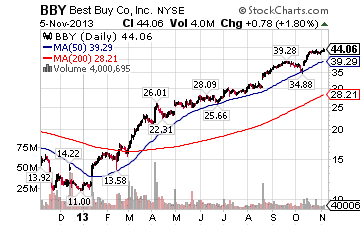 Best Buy Co. Inc. (NYSE: BBY) - The consumer electronics giants has been one of the best performing stocks so far this year. Much of the increase in the stock was initially associated with rumors that the founder would partner with a private equity firm to take the company private. No bid materialized by the deadline, and this now looks unlikely.
Best Buy Co. Inc. (NYSE: BBY) - The consumer electronics giants has been one of the best performing stocks so far this year. Much of the increase in the stock was initially associated with rumors that the founder would partner with a private equity firm to take the company private. No bid materialized by the deadline, and this now looks unlikely.
In spite of beating analysts' estimates by a small margin, the company is still not performing well. Sales are projected to continue to decline over the next two years. Best Buy has an enormous amount of store and employee cost dedicated to an industry that is transforming into a primarily online industry.
In order to stay competitive the company will have to lower prices to the point already-thin profit margins disappear. If you have been lucky enough to enjoy the more-than 100% price jump this year, it is a good idea to take your profits before reality drives the stock price down over the next few months.
 Netflix Inc. (Nasdaq: NFLX) - In the last year Netflix has been on a tear, gaining 242%. At $215, NFLX is far from its all-time high, which is just below $300. But with a P/E of 527, its stock is certainly overrated.
Netflix Inc. (Nasdaq: NFLX) - In the last year Netflix has been on a tear, gaining 242%. At $215, NFLX is far from its all-time high, which is just below $300. But with a P/E of 527, its stock is certainly overrated.
This company is doing a lot of things right, such as developing original content and expanding internationally, but this is a competitive business and all the good news appears to be reflected in the current stock price.
Netflix trades at more than 500 times earnings and is at almost 60 times the optimist analyst estimates for 2013. Should it fall short of analysts' expectations, or we endure a broader market tumble, this stock could easily give up its 2013 gains. If you have ridden the stock higher, it's probably time to step off the train before it reverses direction.
The only way these stocks would be "Buys" again is if there was a steep sell-off. With all trading at more than 30 times earnings, they have a long way to fall before making it back into the "stocks to buy" category. Investors should be cautious if they recently purchased shares.
A Quick Primer on Shorting Stocks
Besides simply selling a stock and avoiding a fall in price, many investors short stocks to profit as they drop. If you've never heard the term before - and many investors still haven't - shorting stocks involves selling stocks on margin and reaping the rewards as the share price decreases.
Why would you do that?
Shorting overvalued stocks can lead to profits when others are crying in their beer. It's a way to keep you fully invested or otherwise in the game, especially when the markets are as unsettled as they are right now.
But you have to be careful. Despite the fact that shorting stocks can be a quick path to riches, not all stocks are the same when it comes to betting against them.
In that sense, short selling (at least the way I encourage investors to practice it) is no different than regular upside investing.
You want to diversify your holdings and use very strict risk management to control your exposure by not having more than 2.5% of your assets in any one position or 20% of your holdings in any given sector.
"Finally a site with info worth looking at without a 10-minute "I said it 3 times" commentator trying to sell something. I want a letter that will give good sound reasons to buy or sell whichever stock is highlighted. I've found just that with Investors Alley." – Ken Berscheit, Wyoming |
||
You want to short stocks in conjunction with the rest of your holdings, not in lieu of maintaining a properly concentrated portfolio. Despite what you may think, shorting stocks is not a game for market-timers or an exercise in timing.
As for how you select your target, that's not really different either.
How to Find Short "Targets"
For example, you don't ever want to bet against a stock just because it's expensive or even overvalued. Instead, you want to find a compelling reason for failure or a lower valuation.
I laid out seven of them last year when I suggested that Apple (Nasdaq: AAPL) may be the short of a lifetime rather than the next best thing since sliced bread.
At the time, I reasoned that:
- Apple was a bubble based on technical parallels to the Nasdaq bubble of 2000.
- Its products were faddish and driven by new product launches rather than sustained production.
- A change in leadership may produce slower or greatly varied product development.
- Short interest was an ultra-low 9.8 million shares; it seemed logical to take the other side of the bet if everybody was so bullish.
- Analysts were almost uniformly bullish which is a very bearish sign, according to past corrections.
- Apple's profit margins were disproportionately high in its industry.
- A carrier failure or subsidy change may soften the company's fundamentals.
Apple rose a bit further to a peak of $644, then fell 17.68% over the following few weeks to $530.12. And now it's down just above $400.
"I like Investors Alley because you actually give the names of the stocks. One can research and inspect them. So many of these sites just tease but never give the names. It's a waste of time even looking at the articles. Thank you so much. I just wanted to express my appreciation for your info." – Natalie Giroux, Canada |
||
Other negative attributes I look for include insider selling and problematic accounting. Both can be hard to spot in a timely fashion but that doesn't mean you shouldn't look.
Armed with a good dose of skepticism, you can find companies that are likely to fall apart in pretty much any market anywhere in the world if you look hard enough.
Take action on strong up days when the believers are pushing the stock for all it's worth - every stock has them. Some brands like Apple (Nasdaq: AAPL), Harley Davidson (NYSE: HOG) and Facebook (Nasdaq: FB), for example, are particularly well defended by brand loyalists.
That's why you've got to have a thick skin when you are shorting stocks because you're essentially betting against the success so many people hope for.
Your friends will accuse you of being un-American or a vulture - mine certainly have over the years. Worse, any butthead with an Internet connection can take a potshot at you in today's socially driven media age.
Stick to your guns. They'll get over it when they figure out how much money they could have made and how they can get in on the action.
Love this special report? Hate it? We want to hear from you! Tell us what you think of this report and what you'd like to see on Investors Alley in the future. Click here to email us your comments and feedback. |
||
The typical turnaround stock has stumbled badly, with the share price punished severely for overblown media mishaps or trouble in the sector.
That's why finding turnaround stocks to buy is not for everybody. There are some reasons people tend to shy away from it...
First, finding the best turnaround investments requires more patience than trading or flipping stocks over the short term. A turnaround stock usually takes a year or longer to show results.
Second, you have to be prepared to live with price volatility. There's often high volatility during the turnaround period.
Also, it's highly unlikely you will time things so perfectly that the stock doesn't slip more before it climbs higher.
However, if you have the patience and money to play with, turnarounds can be some of the best investments you'll ever make - and provide the type of returns most short-term investors will never realize.
But there's more to it than a rebound in profits and revenue - the best turnaround stocks to buy also have undervalued share prices.
For example, investors wouldn't want to buy stocks like Tesla Motors Inc. (Nasdaq: TSLA) and Delta Air Lines Inc. (NYSE: DAL), even though they indeed have analysts' blessing and are likely about to see their bottom line substantially improve.
But these are not ideal stocks to buy for individual investors for two reasons: 1) They have both seen share prices skyrocket this year, with their stock up 444% and 102%, respectively, and 2) are already heavily owned by institutional investors.
Plus, Tesla-type stocks are far more likely to suffer an earnings shock than an earnings pop at this point because everyone expects them to turn profitable and enter a growth phase. If their earnings disappoint even slightly, investors' exit will be abrupt as large funds withdraw.
So, investing in rags-to-riches stocks means choosing those that are not mainstream.
That means look for stocks that are braced to enter a strong growth period but are under-owned by the large institutions. Then, when the larger institutions do recognize their financial strengths, your portfolio will be well positioned to enjoy the surge in stock prices.
Looking at the market now, here are a few companies that have the potential to be the next best "turnaround" investments out there.
- The first such candidate right now is Atlantic Power Corp. (NYSE: AT).
 The company has seen its stock slashed this year from more than $10 a share to less than $5. A weak economy and high leverage forced the company to cut its dividend by more than 60%. AT fell off a cliff after the payout cut announcement on Feb. 28, slipping 40.7% by Mar. 4.
The company has seen its stock slashed this year from more than $10 a share to less than $5. A weak economy and high leverage forced the company to cut its dividend by more than 60%. AT fell off a cliff after the payout cut announcement on Feb. 28, slipping 40.7% by Mar. 4.
But the reason this is a potential turnaround stock to buy is that this company appears to have the means to weather the storm and get back on a profitable track long term.
AT has a strong collection of electric power generation assets, with 29 plants capable of producing more than 2000 megawatts of electricity. The majority of its plants produce clean energy using solar, wind, biofuels, and natural gas to produce power. All of the plants are located in major markets across the United States and Canada.
The company is focusing on paying down its debt load to reduce the chance of future financial problems. In the last quarter it paid down more than $170 million of long-term debt and is looking to sell non-core assets to further reduce indebtedness. Even after cutting the dividend, the shares still yield more than 8% at the current price. Atlantic Power shares sell for about one-half of book value and appear to have substantial recovery potential over the next few years.
Patient investors could easily see the stock double back to where it was before the dividend cut.
- This next potential turnaround stock to buy has ties to the lucrative oil and gas industry - ION Geophysical Corp. (NYSE: IO).
 The company provides advanced seismic acquisition equipment, software, seismic data-processing services, and seismic data libraries to the global oil and gas industry. These are used by exploration and production companies to generate high-resolution images of the Earth's subsurface during exploration, exploitation, and production operations.
The company provides advanced seismic acquisition equipment, software, seismic data-processing services, and seismic data libraries to the global oil and gas industry. These are used by exploration and production companies to generate high-resolution images of the Earth's subsurface during exploration, exploitation, and production operations.
This is a business that should see strong growth in the years ahead as oil and gas companies scramble to boost production to meet increasing demand.
The short term has been a little more difficult for this company. The stock price has been punished for missing Wall Street's earnings forecasts. Now shares have slipped more than 25% in the last few months.
In spite of the short-term difficulties, the company has exposure to what will be the fastest-growing segments of the energy exploration industry.
With 20 locations around the world, ION is providing data for companies looking for oil and gas below the oceans, in the Arctic, and in the unconventional fields in the United States. The company also just added several data libraries, including portions of the Arctic, Latin America, Africa, and Australia, that should see strong demand and improve the top and bottom line.
Increased exploration and production activity in the Gulf of Mexico should also help the company regain footing in 2014. Analysts expect earnings to double next year and grow more than 15% annually for the next five years.
If they are close to right, this stock has the potential to soar as oil and gas demand picks up.
- Realogy Holdings Inc. (NYSE: RLGY), a real estate services company, is a perfect example of a turnaround stock to buy that could soon welcome a surge in institutional appetite that would drive its shares higher.
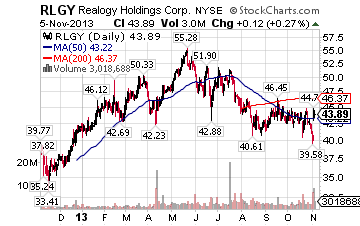 Realogy offers real estate and relocation services in the United States and internationally. The company franchises some of the leading names in real estate brokerage, including Century 21, Coldwell Banker, Coldwell Banker Commercial, ERA, Sotheby's International Realty, and Better Homes and Gardens Real Estate.
Realogy offers real estate and relocation services in the United States and internationally. The company franchises some of the leading names in real estate brokerage, including Century 21, Coldwell Banker, Coldwell Banker Commercial, ERA, Sotheby's International Realty, and Better Homes and Gardens Real Estate.
Reology has 3,600 offices worldwide in 102 countries and territories and about 238,900 independent sales associates worldwide.
The company also owns a real estate brokerage division that operated under the Owned Real Estate Brokerage Services segment. It owns and operates a full-service real estate brokerage business under the Coldwell Banker, Sotheby's International Realty, ERA, Corcoran Group, and CitiHabitats brand names.
Realogy has been losing money lately, but analysts expect it to show positive earnings next year. The consensus analyst estimate of five-year earnings growth for the real estate firm is 22%, and the company appears ready to enter a boom phase as real estate markets improve. In spite of the anticipated strong growth, institutional investors own just 54% of the shares outstanding.
- Multi-Fineline Electronics Inc. (Nasdaq: MFLX) is another one of these ideal turnaround stocks to buy. This company is anticipated to stage an earnings breakout and enter a strong growth phase, analysts say.
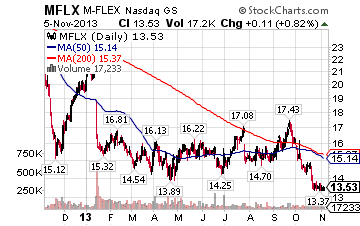 Based in California, Multi-Fineline engineers, designs, and manufactures flexible printed circuit boards and related component assemblies for the electronics industry. It works with original equipment manufacturers and electronic manufacturing service providers in the electronics industry for applications such as mobile phones and smartphones, tablets, consumer products, portable bar code scanners, data storage, and medical devices.
Based in California, Multi-Fineline engineers, designs, and manufactures flexible printed circuit boards and related component assemblies for the electronics industry. It works with original equipment manufacturers and electronic manufacturing service providers in the electronics industry for applications such as mobile phones and smartphones, tablets, consumer products, portable bar code scanners, data storage, and medical devices.
So, Multi-Fineline is among great rebound stocks to buy because it's ready to benefit from increased consumer spending for consumer electronics and pent up demand for business IT products over the next several years.
In fact, Multi-Fineline is expected to turn a profit in 2014 after losing money this year. And its earnings growth for the next five years is anticipated to be 20% annually.
Yet in spite of this bright outlook, large institutions and other big funds own just 33% of this stock outstanding right now, making it the perfect time to add it to your list of stocks to buy now.
As the improvement at Multi-Fineline attracts more attention, the buying pressure from these large investors could easily push the stock price substantially higher in 2014 to provide savvy investors with a nice return.
- The next turnaround investment is an engineering and construction company that builds complex offshore platforms for the oil and gas industry. It constructs floating and fixed facilities, as well as pipelines.
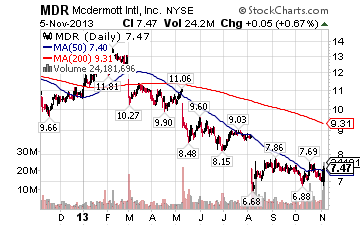 The company is McDermott International (NYSE: MDR).
The company is McDermott International (NYSE: MDR).
The company has seen earnings fall since 2007 from $2.66 to what might be $.40 per share this year.
The stock has fallen over the same time from above $60 per share to less than $8 today.
The near-term outlook for business is moderate, with backlogs staying fairly stable at around $5 billion.
However, here's why I'm keeping my eye on this one...
Global demand for oil and gas is going to increase over the next five years as will demand for offshore drilling and storage facilities.
Earnings should better than double in 2014 and could easily be back above the $1.50 mark in five years. A stronger economy that leads to higher oil and gas prices could push that number closer to $2.00. The stock can easily sell at three to four times the current price at some point over the next five years, giving patient investors a solid return on their investment.
- LSI Corp. (Nasdaq: LSI) is another company with results suppressed by a weak economy. It currently trades slightly above $8 a share.
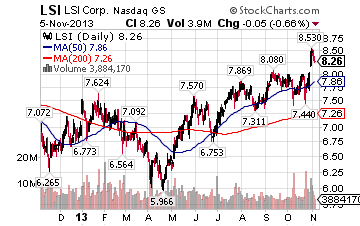 The company makes semiconductors for the storage and networking markets. The continued contraction of the personal computer and hard disk drive markets has continued to hurt LSI's earnings.
The company makes semiconductors for the storage and networking markets. The continued contraction of the personal computer and hard disk drive markets has continued to hurt LSI's earnings.
There are signs now that excess supply in these markets is being worked off and the business will stop declining. Sales should finally begin to grow again in 2014 according to most analysts and industry observers.
This combined with LSI's renewed focus on the fast growing flash drive market should allow them to resume stronger earnings growth over the next few years. The company's new hybrid drive products are expected to be well received by cloud computing, Web providers and other segments of the industry.
As the company continues to introduce new products and the PC markets stabilize LSI should be reporting record profits. After several years as a lagging issue the company could become a growth leader over the next market cycle and reward patient investors.
- Finally, Casella Waste Systems Inc. (Nasdaq: CWST) remains a favorite of many turnaround investors.
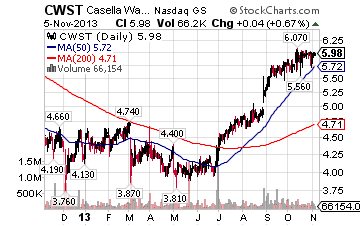 The company has seen weak results as a result of the fragile economy in its operating regions. Landfill volumes have been down, and the pricing of recycled products has been very weak.
The company has seen weak results as a result of the fragile economy in its operating regions. Landfill volumes have been down, and the pricing of recycled products has been very weak.
At about $6 a share, the stock is about one-third of where it was in 2008.
But as the housing market recovers and new construction and home refurbishing picks up, so will Casella's business. Increased building will generate substantial waste volumes.
Consumer spending growth will also help.
The company has a valuable collection of assets, including 17 recycling centers, 10 landfills, 31 transfer stations and four waste-to-energy operations.
If an improving economy allows management to focus on their goals of producing free cash flow and paying down debt, shares of Casella could provide patient, disciplined investors with monster returns. This stock could easily double or more over the next several years.
Best Stocks for 2014: Cheap Stocks with a Dividend
Individual investors have always had a soft spot for cheap stocks to buy, but get scared away because traditional Wall Street dogma would have you believe that these stocks are too speculative and dangerous for most individuals.
But cheap stocks can be among the best stocks to buy because they bring several advantages to a portfolio.
For starters, if you're buying a quality low-priced stock, you're getting high value for a discount. That's an obvious benefit.
There is also a not-so-obvious benefit...
Large institutional investors such as pension funds and some mutual funds are prohibited from buying stocks that trade below $5. As stocks slip below that price, analysts often stop covering the company due to a lack of interest from larger investors.
The lack of analyst coverage gives you a chance to buy before the stock comes to the attention of large institutional buyers. With cheap stocks, investors are less likely to be trading against the high frequency and short-term traders who need higher-priced, more liquid stocks to conduct their routine business.
Another note about cheap stocks: Hunting for cheap stocks to buy will often take investors to foreign companies' stocks trading in the United States.
Some investors avoid these shares - but you shouldn't. There are very profitable and affordable opportunities in this space. They can also offer a nice balance in your portfolio to shares of U.S. companies that haven't tapped into overseas economic growth.
Using the widely available web-based stock screeners, an investor can quickly compile a list of international low-priced stocks that trade at discounted valuations and have outstanding long-term potential.
I put together a couple cheap stocks to buy now that are both under $5, are benefiting from economic recovery, and have more than 4% dividend yield...
- One such company is Alumina Limited (NYSE ADR: AWC), an Australian aluminum company.
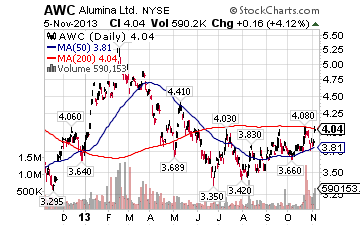 Alumina, which mines and refines aluminum, operates eight refineries and two aluminum smelters and owns or has interest in seven mining operations. It has a shipping operation that transports aluminum-related raw materials.
Alumina, which mines and refines aluminum, operates eight refineries and two aluminum smelters and owns or has interest in seven mining operations. It has a shipping operation that transports aluminum-related raw materials.
Alumina has a 40% stake in a joint venture with Alcoa (NYSE: AA), Alcoa World Alumina. Aluminum prices have been falling in the face of weak global demand, and inventories have piled up over the past couple of years. But as excess inventory is pared down, aluminum companies are stocks to buy now. These companies will see their bottom line and stock price increase fairly rapidly.
Along with other global aluminum producers, Alumina has been reducing capacity and lowering its cost structure by closing unprofitable facilities.
The company also sold stock earlier this year and used the proceeds to pay down debt levels and reduce interest expense. This reduced cost structure will add to the company's earnings growth potential when the markets do recover.
The few analysts who watch Alumina estimate that earnings should average gains of 15% annually over the next five years - but its stock could soar much higher.
Now Alumina stock is trading at 90% of book value, so the growth potential does not appear to be reflected in the current stock price. Alumina looks like a bargain stock that could easily double over the next five years.
- Teekay Tankers Ltd. (NYSE: TNK) is another cheap foreign stock to buy now that appears to have enormous recovery potential over the next few years.
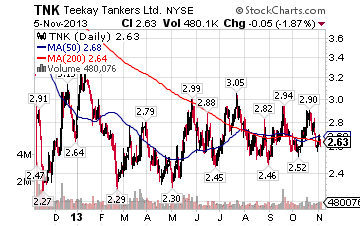 The Bermuda-based company has a fleet of 27 double-hulled vessels of various sizes and has seen its stock price decline as the shipping industry suffered from overcapacity and a weak economy. It's among the ideal shipping stocks to buy as the global economy improves.
The Bermuda-based company has a fleet of 27 double-hulled vessels of various sizes and has seen its stock price decline as the shipping industry suffered from overcapacity and a weak economy. It's among the ideal shipping stocks to buy as the global economy improves.
The recovering economy should help increase oil demand and the need for shipping crude oil and refined products worldwide. Overcapacity is a rampant problem in the shipping industry, but some older vessels are being scrapped, and new orders have slowed. Eventually the overcapacity problem should ease.
However, shares of Teekay Tankers are priced in a way that ignores the likelihood of improved capacity. The stock trades at just 80% of book value and is down more than 30% over the past year.
Although there are very few analysts that follow the stock, those that do think it will turn the corner next year and report profits for 2014. The company has paid a dividend for 22 straight quarters now, and the shares yield 4.38% at the current price.
TNK traded at $12 before the global recession set in, and a recovery to even half that amount over the next few years would double the money of those who purchased the stock now.
Best Stocks for 2014: IPOs
After Facebook's disaster, the IPO market looked bleak.
But thanks to a string of successes in 2013, the IPO market is heating up again.
In fact IPOs that debuted in 2013 are up a combined 35.29%, with a 3-to-1 ratio of positive to negative offerings out of the more than 100 IPOs this year.
As we conclude 2013 and enter 2014, the overall pessimism that engulfed the IPO market since Facebook went public has certainly disappeared.
Before we show you which IPOs to look forward to, here's a recap of some successful debuts.
The IPO market started rebounding at the end of 2012.
After the big hiccup with Facebook, there was pent up activity. Investors started moving toward anything with growth, and things started to return to normal.
 One of the better recent IPOs was Tableau Software Inc. (NYSE: DATA). The Seattle,WA-based firm is a provider of cloud-based applications and its list of over 10,000 clients includes Apple and Coca-Cola.
One of the better recent IPOs was Tableau Software Inc. (NYSE: DATA). The Seattle,WA-based firm is a provider of cloud-based applications and its list of over 10,000 clients includes Apple and Coca-Cola.
Tableau went public in May with a $31 price tag and closed above $50 on its first day of trading. It recently traded 132% higher than its offering price, at $72.
Tableau's IPO is part of a successful trend in cloud-based companies going public.
In addition to Tableau, these include Workday, Demandware, Splunk, ServiceNow, Guidewire Software and Palo Alto Networks - and high-end branded goods such as Michael Kors Holding Ltd. and Prada that appeal to consumers in emerging markets.
Based on the performance of the above companies, there are plenty of reasons to be excited for upcoming IPOs.
And by following these rules, you will be ready to profit.
The Secret to Playing IPOs
Ever since the Dutch East India Company became the first to issue stocks and bonds to the public in 1602, investors have seen initial public offerings (IPOs) as the road to riches.
Think back to the dotcom craze of the late 1990s. You'll remember it spawned a feeding frenzy among investors chasing after internet IPOs on an almost daily basis.
It wasn't long before investors on Main Street took the bait after watching hordes of new college graduates in Silicon Valley become instant millionaires.
But as companies with unproven business models executed massive IPOs with sky-high prices, many investors who succumbed to the siren call got clobbered.
Pets.com for instance, raised $82.5 million in an IPO in February 2000 before imploding nine months later. And EToys.com stock went from a high of $84 per share in 1999 to a low of just 9 cents per share in February 2001.
In both cases, small investors were left holding the bag. The point is IPOs have always been high-risk, high-reward.
Here's what you need to know...
First of all, most companies go public to raise capital, either by issuing debt or stock. After all, being publicly traded opens the door to potentially huge returns for the owners.
But that's not all.
Public companies pay lower interest rates when issuing bonds. They also can issue more stock to grow through mergers and acquisitions.
Then there's the prestige factor, the pure ego satisfaction of hobnobbing with the fat cats on Wall Street.
But from an investor's point of view, the road to prosperity with companies going public is often fraught with peril.
You see, most IPO s leave retail investors completely behind. Typically only the biggest clients with the deepest pockets are going to get in on a hot IPO.
These institutional clients usually have a cozy relationship with one of the underwriters - such as investment banks Goldman Sachs, JPMorgan Chase or Morgan Stanley.
The underwriters work behind the scenes with the company to compile the proper regulatory filings with the Securities & Exchange Commission, handle the paperwork and determine the offering price of the stock.
 |
||
Market Timing & Trading Months 3 Best Trading MonthsJANUARY: Absolutely our favorite month as the "January Effect" takes place. The "January Effect" is essentially buying in stocks that were heavily sold for tax loss reasons at the end of the year. This is especially true in small caps and speculative stocks. January is also often a very strong month for the markets as post holiday sales figures are released. Even in a bear market, January will always provide us with a strong performance. JUNE: Summer doldrums? Not a chance. June is typically the month traders try to make enough to compensate for the doldrums of late July and August. More importantly, it is Russell re-constitution, and positioning in small caps prior to the institutional buying that occurs when new stocks are added to the Russell 2K can result in exceptional short term percentage gains. NOVEMBER: Typically, October is the worst month for the markets, and November is a rally month as the "Santa" rally begins and mutual fund tax loss selling is over since their fiscal years typically end October 31. Market lows are often set in October, with rallies out of those lows in November. 3 Worst Months for Trading and Why:Our final three months are our least favorite for trading. While they sometimes produce strong performance, these are typically our lowest percentage months for gains. OCTOBER: Historically, the worst performing month for the markets. Combine that with mutual fund tax loss selling, which ends October 31, and you get one of the most difficult months for trading. We typically enter more shorts in October than any other month, and try to position in stocks that were hit by fund tax loss selling for a little rebound in November. |
||
If the underwriters know the IPO will be in great demand and the price is likely to jump, they'll shower their favorite institutional clients with an allocation at the initial price.
But retail investors can still make money on companies going public. You just have to do your homework.
For instance, Amazon.com (Nasdaq: AMZN) went public on May 15, 1997, with an IPO valuation of $441 million. Today it's $138 billion.
EBay Inc.'s (Nasdaq: EBAY) IPO valuation on Sept 24, 1998 was $2 billion. Today it's $67 billion.
Just remember, don't buy a stock just because it's an IPO -- buy it because it's a great investment. 99% of the time, the success of an initial public offering (IPO) is determined by the firm - or firms - who sponsor it, and how early you can get in.
And the best time to buy IPOs is AFTER the initial mania settles down.
This could be weeks or months after the initial offering. The key is to be patient.
There are two reasons these delayed entries into IPOs can be golden for those who jump in at precisely the right time:
- You have a better idea of what the business is... and what its true potential can be.
- The price is usually settled or even deflated.
Top 8 IPOS to Watch
1) Square - Last August Starbucks partnered with Square in a $25 million deal that lets the mobile payments company process all of the coffee giant's debit and credit transactions. Square should continue gaining popularity as the "mobile wallet" industry takes off. Besides being a major player in this up and coming industry, Square is often thought of as a takeover target.
2) Chrysler - After a 15-year hiatus from trading on the markets, Chrysler will once again trade publicly. In the second quarter of 2013 Chrysler saw its profits rise 16% year-over-year. What's more, the Auburn Hills, MI-based company now has annual net profits of $750 million.When Chrysler has its IPO sometime in late 2013 or early 2014, it hopes to have the success that rival carmakers GM and Ford have had lately, up 45% and 70% respectively this past year.
3) Aerie Pharmaceuticals - Aerie is a NJ-based developmental drug producer primarily engaged in developing glaucoma treatments. In May the company successfully completed a Phase 2b clinical trial for its leading glaucoma drug AR-13324. Like many bio-techs the firm does not earn a profit, losing $10.4 million the first half of 2013. Yet, glaucoma, which affects 2.2 million Americans and is the leading cause of blindness, has no known cure.
4) Glam Media - Glam Media is a vertical-media company with entertainment and lifestyle Websites and blogs mostly geared toward a female demographic. The New York, NY-based company generates revenue through ads and has been profitable since 2010. Glam continues to grow through acquisitions and currently has 356 million unique visitors per month to its site. In June of 2012 Glam was rated the #1 digital lifestyle Website in the world by comScore.
5) Rapid7 & 6) WhiteHat Security - One or both of these companies could be the next huge cybersecurity play, as both are thought to go public in 2013. Rapid 7 saw its revenue grow by 75% in the third quarter of 2012 and continues to expand its product portfolio. WhiteHat was founded by a former Yahoo! Inc. (Nasdaq: YHOO) information security chief, and dozens of Fortune 500 companies rely on WhiteHat for protection. As the world becomes more complex, uncertain, and digital, expect cybersecurity companies to grow in importance and value. Plus, both of these are prime takeover targets by larger security and defense firms.
7) Dave & Buster's - Last October it pulled its IPO off the shelf, but keep an eye out for an offering some time in late 2013/early2014. The company provides the best arcade and gaming experience for adults and was hoping to join other restaurant companies such as Bloomin' Brands Inc. (Nasdaq: BLMN) and Chuy's Holdings Inc. (Nasdaq: CHUY) that have had successful IPOs this past year.
8) Twitter - When this San Francisco-based social media company goes public it will be the biggest IPO since Facebook's. While some say Twitter is not prepared for Wall Street, it has filed for an IPO and will trade under the ticker TWTR. In 2012 the company posted revenue of $317 million. That's 10 times less than the $3.7 billion Facebook reported its full year before going public. For now, investors will have to wait and see what TWTR is priced at before even thinking of buying.
3 IPOs to Avoid
All three of these companies present huge risks for investors and should be avoided.
1) Pinterest & 2) Tumblr - Both of these companies face issues similar to Facebook's in terms of generating profits and revenue from their user base, as well as monetizing mobile users. Pinterest has not proven its business strategy is legitimate and has even admitted it does not know how to turn its user base into profits. While just as popular as Pinterest and Facebook, Tumblr is an even riskier IPO to consider, and generates minimal revenue. Even though both sites are incredibly popular, their fate as public companies could easily follow Facebook's path.
3) Living Social - The vouchers Website might go public in 2013, but its business structure is too similar to Groupon Inc.'s (Nasdaq: GRPN), which has done awful since its IPO. After touching $30 on its IPO day, GRPN immediately began to sell off and currently trades around $8. If Living Social has an IPO make sure to avoid it.
Best Sector of 2014: Energy
Right now, many investors are getting swept up by trendy, headline-making companies like Facebook (Nasdaq: FB) or Twitter.
Investing in stocks like these can be risky if the timing is wrong. That's especially true now, when U.S. budget battles can trigger stock market volatility that sends trend-based stocks like Facebook into a free fall.
Instead, investors should look at low-risk, high-gain "must-have" markets.
The best must-have markets are in front of us at all times - so necessary to our daily lives that they will not disappear.
Love this special report? Hate it? We want to hear from you! Tell us what you think of this report and what you'd like to see on Investors Alley in the future. Click here to email us your comments and feedback. |
||
Even better: They're largely immune to Washington's hijinks.
And they're flooded with money.
That's why it's the perfect time to invest in energy.
Money Morning Chief Investment Strategist Keith Fitz-Gerald says energy is a "$12 trillion market that isn't going away any time soon."
These Billion-Dollar Numbers Say it All
You see, the world's population is growing at an astounding rate.
Today, there are 1.8 billion middle-class consumers in the global economy. By 2030, we can expect 3 billion more - that's a 266% increase.
And the existing power infrastructure can't keep up with that rate of growth.
For instance, power quality issues in the Unites States already cost more than $250 billion a year to resolve. In South America, the demand for electricity will double by 2020, and it completely lacks the grid to support that kind of growth - so outages will become commonplace.
That means there's going to be major investment in increasing energy supply to keep up with soaring demand. And those are just energy infrastructure problems facing the Americas.
The accompanying map shows how much global energy investment is needed in the coming years to keep up with demand.

This is why investing in energy will deliver gains far longer than any of today's trendy stocks.
Just look at these shocking numbers that reveal how big of an investment opportunity the energy market is (numbers courtesy of McKinsey Global Institute):
- The U.S. will spend at least $540 billion per year in order to meet energy demands from 2013 to 2030. Worldwide, that number is roughly $700 billion per year. And energy is not an expense that will get slashed by cost-cutting governments. "There's not a government in the world that can't afford to keep the lights on. This spending is absolutely at the top of the priority list," Fitz-Gerald said.
- On the low end, that means the world will spend approximately $12 trillion on energy needs by 2030; Fitz-Gerald believes we are looking at a figure closer to $15 to $17 trillion. To put that figure in perspective, there is approximately $1.22 trillion of U.S. currency presently in circulation, of which $1.17 trillion is in Federal Reserve notes.
- Oil demand will increase with population growth, but the oil we need is increasingly challenging to access. The last decade has seen a doubling in the average cost to bring a new oil well on line. "We've got to drill deeper, we've got to drill horizontally, and we've got to use new technology to get the same amount of oil to the surface and in production," Fitz-Gerald explains.
Plus, there's going to be more reliance on these hard-to-reach, unconventional energy sources as a growing percentage of the world's oil fields are down for repairs, are badly in need of capital investment, and are increasingly subject to terrorist and military action.
- Up to $1.1 trillion is spent by governments annually on resource subsidies. Several countries commit at least 5% of their gross domestic product (GDP) to energy subsidies.
For instance, in 2011, the United States government spent $24 billion on energy subsidies. To break it down even further, renewable energy and energy efficiency accounted for $16 billion, and the fossil-fuel industry received $2.5 billion in tax breaks, according to the Congressional Budget Office. "I think that the percentage of GDP spent on energy subsidies is going to rise because the trade-off is between supplying energy and massive civil unrest; governments will obviously choose the former," Fitz-Gerald notes.
7 Bullish Cases for Silver in 2014In this time of economic uncertainty, investing in silver and other precious metals instruments is a must.By devoting even a small portion of a portfolio to precious metals, investors gain valuable protection against inflation, stock market drops, and any other repercussions from Washington's debt-ceiling drama. So far in 2013, investing in silver has been rocky. Silver prices have dropped nearly 30%, likely under pressure in the short term due to sluggish key factors in global markets. But despite the short-term performance, silver prices are still a whopping 250% higher than its 2008 lows. And long-term prospects look particularly bullish. The growing demand for emerging products, China's introduction of silver futures, new movement in India, and continued U.S. government dysfunction all point toward silver market growth. Taking these factors into account, plus 2013's fresh lows, means right now is a great time to get on board with silver. Here are several important factors that will push silver prices higher in the year ahead.
Here are two interesting ways to play silver now before the price climbs higher: Global X Silver Miners ETF (NYSE: SIL) is a one-stop shop of the larger primary silver miners. This should offer good exposure and leverage to silver, especially as silver equities are trading at historically very cheap levels. ProShares Ultra Silver (NYSE: AGQ) offers a two-for-one leverage on the silver price, both up and down, but with no margin calls. |
3 Reasons to Buy Gold StocksA strong stomach and a tremendous amount of patience are required if your invested in gold stocks these days, as miners have been exhibiting their typical volatility pattern.That's why I often say to anticipate before you participate, because gold stocks are historically twice as volatile as U.S. stocks. As of March 31, 2013, using 10-year data, the NYSE Arca Gold BUGS Index (HUI) had a rolling one-year standard deviation of nearly 35 percent. The S&P 500's was just under 15 percent. I believe the drivers for the yellow metal remain intact, so for investors who can tolerate the ups and downs, gold stocks are a compelling buy. Here are three reasons: 1) Gold companies are cheap
And on a price-to-cash-flow basis, gold stocks are trading at bargain basement prices. The chart below shows that average annual cash flow multiples for North American Tier I gold companies have fallen to lows we haven't seen in years. Since January 2000, forward price-to-cash-flow multiples have climbed as high as 26 times. This year, we see multiples at the high end that are less than half of that. On the low end, today's price-to-cash-flow of 6.5 times hasn't been seen since 2001.
Tier I and Tier II companies "offer investors an attractive entry point from an absolute valuation perspective with respect to the broader market," says RBC. 2) Gold companies are increasing their dividends With the Federal Reserve suppressing interest rates, investors have had to adapt and reallocate investments to generate more income. That's where gold companies come in. I have discussed how miners have become much more sensitive toward the needs of their investors as they compete directly with bullion-backed ETFs and bar and coin buying programs. In response to shareholders' desire to get paid while they wait for capital appreciation, gold companies have rolled out dividend programs and increased payouts. "The growth in dividend payout has been spectacular when looking at the industry as a whole," says my friend Barry Cooper from CIBC World Markets. His data shows that over the past 15 years, the world's top 20 gold companies have increased their dividends at a compound annual growth rate of 16 percent. By comparison, gold only rose 12 percent annually.
Not only are gold companies increasing their payouts, the yields offer a tremendous income value to investors compared to government bonds today. Whereas investors receive a 1.5 percent yield on a 10-year Treasury, the stocks in the Philadelphia Stock Exchange Gold and Silver Index (XAU) are paying a full percentage point more! This is a significant change from the past: In April 2008, the Treasury yield was nearly 3 percent more than the dividend yield of the XAU. In addition, the yields of gold stocks have been climbing over the past year while the 10-year Treasury remains low.
3) Enhanced returns in a diversified portfolio We have long advocated a conservative weighting of 5 to 10 percent in gold and gold stocks because of the inherent volatility you are seeing today. But despite the extreme moves, there's a way to use gold stocks to enhance your portfolio's returns without adding risk. Take a look at the efficient frontier chart below, which creates an optimal portfolio allocation between gold stocks and the S&P 500, ranging from a 100 percent allocation to U.S. stocks and no allocation to gold stocks, and gradually increasing the share of gold stocks while decreasing the allocation to U.S. equities. The blue dot shows that from September 1971 through March 2013, the S&P 500 averaged a decent annual return of 10.34 percent. What happens when you add in gold stocks? Assuming an investor rebalanced annually, our research found that a portfolio holding an 85 percent of the S&P 500 and 15 percent in gold stocks increased the return with no additional risk. This portfolio averaged 10.96 percent over that same period, or an additional 0.62 percent per year, over holding the S&P 500 alone. Yet the average annual volatility was the same.
Although 0.62 percent doesn't seem like much, it adds up over time. Assuming the same average annual returns since 1971 and annual rebalancing every year, a hypothetical $100 investment in an S&P 500 portfolio with a 15 percent allocation in gold stocks would be worth about $7,899. This is greater than the $6,246 for the portfolio solely invested in the S&P 500 while adding virtually zero risk. Case Study: Alamos Gold (AGI)
To the delight of many mining analysts, the company beat analysts' expectations on both the top and bottom line. Alamos grew its production to 55,000 ounces of gold from 40,500 ounces in the same quarter last year. In addition, AGI boasts an 8.76 percent free cash flow yield, allowing executives to build the business through paying off debt, making acquisitions or returning money to shareholders. In Alamos' case, the company announced a stock repurchase of 10 percent of its float over the next 12 months. While the company trades at a premium to most junior producers, it may be well worth the extra coin, as its low cost profile, cash generation and self-funding capabilities, as well as its discipline in returning capital to shareholders fit our growth at a reasonable price (GARP) model. |
Barron's List of the Most Undervalued Companies
Barron's recently published its annual list of the 500 top U.S. and Canadian companies based on sales growth, cash flow, and return on investment, delivering juicy choices for investors on the hunt for stocks to buy.
Apple Inc. (Nasdaq: AAPL) took the top spot, with Wesco International (NYSE: WCC) snagging second. Western Digital Corp (Nasdaq: WDC) grabbed No. 3. and DaVita HealthCare Partners Inc. (NYSE: DVA) was No. 4. C.H. Robinson Worldwide Inc. (Nasdaq: CHRW) rounded out the top five.
Landing a spot on the coveted roster is indeed an accomplishment. But it hasn't always been a reliable judge of how a company's shares will perform in the future.
"Great articles and fine analysis. All in a very straight forward and easy to understand, logical presentation of some very basic facts. I like that you back up guidance with facts and plenty of justification." – Carmen Vella, Massachusetts |
||
So, for the second consecutive year, Barron's teamed with financial data and software company FactSet Research Systems Inc. to find the cheapest stocks among its 500 list. FactSet used price/earnings ratios based on earnings estimates for each company's current fiscal year.
Last year's "cheap" list of 30, tracked for a year, averaged a 42% return over the period ended April 26. That's nearly triple the 15.6% gain over the same period for the Standard & Poor's 500 Index.
A trio of energy refiners, all posting triple-digits returns, led the group to lofty gains: Tesoro Corp. (NYSE: TSO); Alon USA Energy Inc. (NYSE: ALJ); and Marathon Petroleum Corp. (NYSE: MPC).
Just two stocks, Hewlett-Packard Co. (NYSE: HPQ) and Exelis Inc. (NYSE: XLS), fell.
This year's bargains are a mixed lot. Here's a closer look at the lowest priced stocks to buy among the Barron's 500.
Refiners: This year's list is again peppered with refiners.
Overall, the group slumped the last few months over worries that potentially stricter regulations would damage profit margins. The White House proposed reducing the amount of sulfur in gasoline and raising auto emission standards. If passed, refiners would eat most of the costs to adhere to the new standard, set to take effect in 2017.
Barron's notes the sector selloff looks done. Moreover, these refiners are profitable, inexpensive and pay attractive dividends.
Here's a handful to consider when looking for energy-related stocks to buy:
"Well-researched and well-written. Best of all quite succinct and the potential negatives honestly described. Good work!" – Bill Watson, Canada |
||
- PBR Energy Inc. (NYSE: PBR)
- Western Refining Inc. (NYSE: WNR)
- Holly Frontier Corp. ( NYSE: HFC)
- Valero Energy Corp. (NYSE: VLO)
- Marathon Petroleum Corp. (NYSE: MPC)
- Phillips 66 (NYSE: PSX)
- Apache Corp (NYSE: APA)
- Aegean Marine Petroleum Network Inc (NYSE: ANW)
- Deltek US Holdings Inc (NYSE: DK)
Financials: Since the financial meltdown of 2008, financials have turned in a mixed showing. Year-to-date, the sector has logged a 45.25% gain thanks to strong earnings from property & casualty insurers and investment services.
"I like that you don't waste our time. You tell what you promised right away. Thank you." – Kay Quinn |
||
Barron's found a few industry names that offer value:
- MetLife Inc. (NYSE: MET)
- Lincoln National Corp. (NYSE: LNC)
- Prudential Financial Inc (NYSE: PRU)
- Reinsurance Group of America (NYSE: RGA)
- Unum Group (NYSE: UNM)
Transportation: The transportation sector historically has been a good leading indicator of both the economy and the stock market. Yet as markets reached numerous milestones, transportation stocks lagged. However, this sector has become a new favorite among some bulls, including CNBC's Jim Cramer.
Two names making Barron's cut:
- Delta Air Lines Inc. (NYSE: DAL) just initiated a dividend and share buyback, rarities among U.S. carriers still clawing their way out of multi-year steep losses.
- United Continental Holdings Inc. (NYSE: UAL) formed from the merger of United Airlines and Continental Airlines.
Technology: The tech sector has also trailed markets. However, the rotation into tech as the second quarter takes off is notable. That suggests plenty of upside for the sector.
On Barron's list are:
- Western Digital Corp (NYSE: WDC)
- Seagate Technologies (NYSE: STX)
- Xerox Corp (NYSE: XRX)
- Ingram Micro Inc. (NYSE: IM)
- Jabil Circuit Inc (NYSE: JBL)
- Exelis Inc. (NYSE: XLS)
- Hewlett Packard Co (NYSE: HPQ)
- Insight Enterprises (Nasdaq: NSIT)
The rest of the bunch includes: The Goodyear Tire & Rubber Co. (Nasdaq: GT); Barrick Gold Corp (NYSE: ABX); Freeport McMoRan Copper & Gold Inc. (NYSE: FCX); RR Donnelley & Sons Inc. (RRD); Pilgrim's Pride (NYSE: PPC), and CF Industries Holdings Inc. (NYSE: CF).
Stocks to Buy with Strong Insider Buying
Tracking insider buying and selling activity has been proven to be a very effective method of finding good stocks to buy.
There is often a good reason why an insider buys stock in the company he works for and it is the same reason you and I buy a stock: He or she thinks it is going to go higher in the months and years ahead.
"On a scale of 1-10 with 10 being highest, you guys are an 11! Keep up the good work." – Robert McGee, Florida |
||
The big difference is that insiders know more about the direction and finances of the company and are in a better position to make an informed decision. Both research and practice shows that following the insiders often leads to excess profits.
When they are buying into shares on the rise - especially when they're hitting 52-week highs - it demonstrates a high amount of confidence in the direction of the company they oversee and operate.
It's important to keep in mind that insiders are investors not traders. They are buying shares with a view towards the long-term outlook of the company and hoping to earn several multiples of their purchase prices over time. They are also frequently early and tend to buy more as the stock declines if their conviction is high.
They know more than we do about new product offerings, business conditions and prospects at their company and when they open up their wallet to buy stocks in the open market investors would be wise to pay attention and consider joining them.
All insider activity is filed with the U.S. Securities and Exchange Commission, so interested investors can easily find out which stocks insiders love - and which ones they're dumping.
Tracking activity can be done using a stock screener like finviz.com, that lists the stock, the buyer's name, relationship to the company, date of sale, number of shares and total value.
Let's take a look at some stocks hitting our radar with high insider buying, making good stocks to buy now if you like to invest where the key officers put their money.
Stocks that Insiders Love
Here are five stocks to buy if you want to bet on insiders moving toward profits.
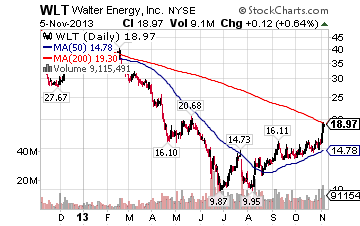 One stock that has seen intense insider buying of late is Walter Energy Inc. (NYSE: WLT). The company primarily provides metallurgical coal for the steel industry, but also sells thermal coal and related products.
One stock that has seen intense insider buying of late is Walter Energy Inc. (NYSE: WLT). The company primarily provides metallurgical coal for the steel industry, but also sells thermal coal and related products.
Business if far from robust for the company. For coal demand to pick up there needs to be an economic company of sufficient strength to revive the steel industry. Most economists do not see that happening prior to 2014 at the earliest.
Management has been focusing on closing marginal mines and controlling expenditures and capital expenditures. Those making the decisions have a lot of faith in what's ahead as 10 officers and directors have made open market purchases of the shares in recent weeks. Both of the top executives, CEO Walter Scheller and CFO William Harvey, have been buyers of the stock in May.
In a more robust economy the company could see its earnings and stock price grow at a rapid rate. Not long ago this stock sold for seven times the current quotation and insiders apparently believe the shares can recover a good portion of that lost capitalization.
Now to the oil and gas industry...
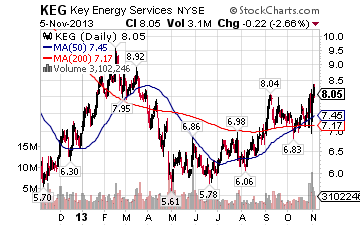 Key Energy Services Inc. (NYSE: KEG) is an oil and gas drilling services business that's been struggling. The company services maintenance, work over and capping services to the oil and gas industry and with natural gas in abundant supply, activity in their sector has been weak.
Key Energy Services Inc. (NYSE: KEG) is an oil and gas drilling services business that's been struggling. The company services maintenance, work over and capping services to the oil and gas industry and with natural gas in abundant supply, activity in their sector has been weak.
The stock has sold off sharply after falling well short of Wall Street's expectations for revenue and earnings. Corporate insiders are taking a longer view of Key Energy's prospects and they were buying a good deal of the shares that panicked investors were selling in the past month.
Five different executives have opened their checkbooks in the past month to make open market purchases of the stocks. The biggest buyer this month has been CEO Richard Alario who spent almost $300,000 to buy an additional 50,000 shares. This stock sold for over $20 a share in 2011 and the people running the company seem to think it can head back close to that level in the future.
 As the controversy over splitting the Chairman and CEO roles at JPMorgan Chase & Co. (NYSE: JPM) at least one board member expressed strong confidence in the future of the investment and banking firm. One of the largest insider buys of the past month was Director James Crown's $14.3 million purchase of shares. That is on top of the $20 million investment he made back in April.
As the controversy over splitting the Chairman and CEO roles at JPMorgan Chase & Co. (NYSE: JPM) at least one board member expressed strong confidence in the future of the investment and banking firm. One of the largest insider buys of the past month was Director James Crown's $14.3 million purchase of shares. That is on top of the $20 million investment he made back in April.
The bank is quickly putting credit problems behind it, and it is estimated JPM will be able to release over $500 million of credit card related loan loss reserves in 2013.
It has been buying back stock under a $6 billion buyback plan and recently received regulatory approval to raise the dividend. Clearly Mr. Crown has a high degree of confidence in the future of the bank and its share price and has backed his convictions with cash.
The last two companies are going to be major beneficiaries of the nascent housing recovery. Investors who also believe in the lasting nature of a housing recovery should play "follow the leader" and add these companies to their long-term portfolio.
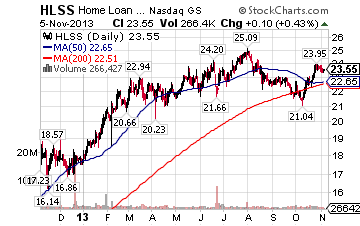 One company that is near new highs and seeing strong insider buying is Home Loan Servicing Corp. (Nasdaq: HLSS).
One company that is near new highs and seeing strong insider buying is Home Loan Servicing Corp. (Nasdaq: HLSS).
The company acquires mortgage servicing assets such as mortgage service advances and servicing rights. The Cayman Islands-based company buys mortgage servicing rights primarily from Ocwen Financial Corp. (NYSE: OCN). The rights are paid monthly and include fees for establishing and maintaining escrow accounts for insurance and taxes as well as forwarding interest and principle payments to the mortgage holder. The assets that the company buys tend to have very little credit and price risk and have been paying off huge for Home Loan Services Solutions.
As revenue and earnings have spiked higher, insiders have been aggressively buying the shares in the open market, like these recent purchases...
President John Patrick Van Vlack has purchased more than 10,000 shares of stock since the beginning of the year with is most recent buy coming on May 29 at $23.29 per share. Chief Financial Officer James Lauter purchased stock the same day for $23.27 a share.
In the last six months officers and directors have purchased more than 188,000 shares of stock even as the price climbed steadily higher.
In addition to the strong price appreciation the stock pays a generous dividend and yields more than 7% at the current price. Investors might be smart to follow the example of insiders in purchasing shares of this high-yielding growth stock.
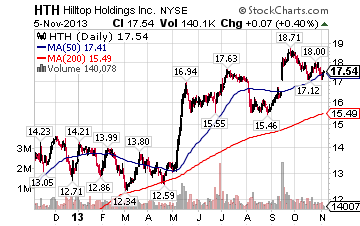 Hilltop Holdings Inc. (NYSE: HTH) is another company that is seeing strong positive insider activity as the stock approaches new highs.
Hilltop Holdings Inc. (NYSE: HTH) is another company that is seeing strong positive insider activity as the stock approaches new highs.
Hilltop is the holding company for PlainsCapital Bank in Dallas, TX and NLASCO, a property and casualty insurance company. The bank engages in business and consumer banking with a strong emphasis on commercial banking and mortgage production. It's the third-largest commercial bank in the Dallas area.
Its mortgage arm, Prime Lending, was the fourth-largest in the United States in terms of purchase units. The financial services division, First Southwest, is one of the largest financial advisory firms in the country.
"This is the best article I have read in the past two years. Concise, easy to understand, makes sense, and gives hope. Thank you for bringing this to my attention." – Larry Schneider, Oklahoma |
||
Hilltop closed its purchase of PlainsCapital in December of 2012 and has seen sales and earnings explode since the acquisition. Founder Jerald Ford has made a fortune for investors in bank stocks in Texas, most notably following the last banking crisis back in the early 1990s. Investors are encouraged by the results of the company so far and have pushed the stock price up to new highs based on the strong growth expectations.
This has not discouraged insiders and officers and directors have been buying the stock heavily all year. So far this year they have purchased more than 87,000 shares of the financial services company.
In the last month alone President James Huffine has purchased more than 30,000 shares sin the open market.
Given the strong results the bank has achieved so far investors might want to follow his lead.
Stocks to Sell that Insiders are Dumping
Just as insider buying can be an excellent indicator of higher prices ahead, insider selling has long been proven as a major red flag in a company.
As far back as the mid-1960s Victor Niederhoffer and Jim Lorie combined on studies that showed insider cluster selling was predictive and indicative of lower prices over the next 12 months. Professor Nejat Seyhun of the University of Michigan has also done extensive research and concluded that when insiders sell in clusters it is likely that lower prices are ahead.
Given that insiders in the aggregate are warning of a market decline, I thought it useful to take a look at which stocks are also showing warnings of lower prices ahead.
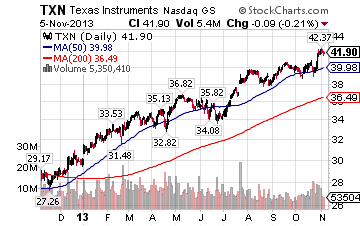 It makes sense that these issues have a high probability of declining over the next several months and should be avoided by most investors. Those who already own shares may want to consider taking profits and more aggressive traders might want to consider selling these issues short.
It makes sense that these issues have a high probability of declining over the next several months and should be avoided by most investors. Those who already own shares may want to consider taking profits and more aggressive traders might want to consider selling these issues short.
One stock that has seen insider selling recently even as the shares have done quite well is Texas Instruments Inc. (Nasdaq: TXN). The stock hit a new high in May and is up over 15% in the last six months.
However, even as investors have piled into the stock, many insiders have been looking for the exits. So far this year, five insiders have combined to sell more than $4.3 million of stock in the open markets. There has also been extensive options-related selling as well. Most investors would do well to dump shares at his point. Given the weak global economy outlook for the semiconductor markets this is one that might be worth the attention of those looking for ideas to sell short.
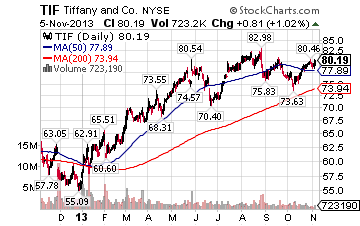 While everyone may love a gift in the little blue box from Tiffany & Co. (NYSE: TIF) this has not been the case with shares of the stock. So far in 2013, three insiders, including the CEO, have combined to sell a whopping $67 million of stock in the open markets. As with other companies seeing clusters of open market selling, the upscale jeweler is also seeing options-related selling.
While everyone may love a gift in the little blue box from Tiffany & Co. (NYSE: TIF) this has not been the case with shares of the stock. So far in 2013, three insiders, including the CEO, have combined to sell a whopping $67 million of stock in the open markets. As with other companies seeing clusters of open market selling, the upscale jeweler is also seeing options-related selling.
As the stock has recovered from the late November sell off, insiders have taken the opportunity to unload their shares and book gains. Holiday sales were flat in 2012 for the company and many think they are losing market shares to less expensive jewelry stores as consumers continue to be cautious shoppers for luxury goods. The stock is not cheap with a price-to-earnings ratio of almost 25 and investors would be best advised to take a pass on Tiffany's.
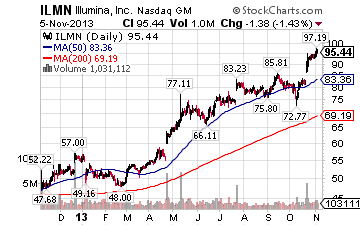 Finally, Illumina Inc. (Nasdaq: ILMN) has performed quite well over the past year, as has much of the healthcare sector. But the stock has several very disturbing red flags. For the first quarter, the biotech company reported revenue of $331 million with massive debt of $860 million.
Finally, Illumina Inc. (Nasdaq: ILMN) has performed quite well over the past year, as has much of the healthcare sector. But the stock has several very disturbing red flags. For the first quarter, the biotech company reported revenue of $331 million with massive debt of $860 million.
The stock is trading at a price-to-earnings ratio of 92, while the biotech industry average P/E is about 20. That's a pretty lofty valuation, especially with such a high amount of debt. It's not hard to see why nine different insiders sold the company's shares in the past 30 days alone, including the CEO and one of the company's founders, while not a single insider purchased any shares. It's likely time to look elsewhere in the biotech space.
The Case for Dividends
Before the financial crisis, prudent investors counted on CDs, U.S. Treasuries and savings accounts to provide them with decent interest income for their retirement.
But thanks to Federal Reserve Chairman Ben Bernanke's zero interest rate policy, prudence has become a tough way to fund your golden years.
With few places to find refuge and income, these cautious investors have been forced to look elsewhere-namely at dividend stocks.
Dividends, long used to pad portfolios with income, are no longer a risk-on or a boring way to invest.
Not only do dividends add value, but with a careful selection across several sectors, an investor can build a nice portfolio covering a broad range of industries.
What's more, dividend-paying stocks provide reliable returns at regular intervals, offer growth potential, and are not typically as economically sensitive as other high-beta and volatile companies.
Another bonus is that when the economy wanes and stock markets fall, dividend stocks pay investors to wait it out until things improve. Market environments like this one are when dividend-paying stocks can be an investor's best friend.
And since cash dividends are paid from a corporation's current earnings and profits, dividend investors have the added prospect that they may see their dividend payments raised as things improve.
That's why dividend stocks have been a long-term bright spot with investors clamoring for higher yields.
Nick Lawson, head of synthetics, macro and cross-selling for Deutsche Bank, told the Financial Times, "We've had a lot of people from fixed income coming into equities. I think it is straight yield. We have all been forced up the yield curve."
Quick Primer on Dividends
All dividends are declared by a company's board of directors every time they are paid. Most dividends are paid quarterly, although some pay monthly, bi-annually, and annually or whenever declared by the company.
Regardless of when they are paid, there are four dates dividend investors need to remember:
- The declaration date is the date the board announces its intention to pay a dividend.
- The date of record is the date an investor must be a holder of record on the companies' books in order to be paid a dividend.
- The ex-dividend date is the most important date investors must consider. An investor must purchase shares of stock prior to the ex-date to be entitled to a stock's upcoming dividend.
- The payment date is the date the dividend will be paid. Of course, investing in dividend stocks goes well beyond yield and cash flow.
How to Pick Winning Dividend Stocks
It seems everyone is scouring the landscape these days for decent income investments to beef up their monthly take-home - especially now with the price of gas and other everyday items skyrocketing.
But it's not too late to find great dividend stocks. You can still get cold, hard cash on a regular basis by investing in companies that reward loyal investors with substantial dividends.
In fact, if dividend-paying stocks aren't a major part of your portfolio, the odds of being successful in the markets are stacked against you.
Need proof?
An exhaustive study of stock market returns from 1871 through 2003 showed that over a 135-year period owning stocks and reinvesting the dividends produced 97% of all stock market returns. Meanwhile a paltry 3% was produced by capital gains.
Dividend stocks are safer too. The very same qualities that allow companies to pay steady dividends means they're much less vulnerable to broad market drops than your typical stock.
And right now corporate America is willing to pay even more in dividends.
Companies are on pace to pay a record $263 billion in dividends to shareholders over the next year even though the S&P 500 Index is still more than 10% below its peak, according to S&P Capital IQ reports.
"We're seeing good dividend increases across the board," Richard Helm of Cohen & Steers Dividend Value fund told USA Today.
It's no secret - a company's dividends play a major role in their performance. Yet many investors completely ignore this important fact.
But you can't just plunk your money down on any old dividend stock.
You see, most people get "income investing" all wrong.
They either settle for dividends that are much too low and never grow a penny or they take on way too much risk.
But you can always do better than that if you know what to look for.
Here are three keys to help you identify a great dividend stock...
Key No. 1: Check the Payout Ratio
Some companies may seem to be humming right along, but the truth is they're consistently paying out more in dividends than they take in. After a few years of this, the cash runs out and they have to cut or eliminate the dividend...or worse.
The payout ratio (P/R) helps you sort the wheat from the chaff.
A low payout ratio means a company has enough cash to pay off debt, with money left over to invest in growing the business.
To calculate the payout ratio simply divide the annual dividend by earnings per share.
"Amazingly detailed article... you could write a book! I was very impressed with the detailed recommendations and great tips. Please keep up the good work!" – Kenneth Tan, Singapore |
||
If a company pays an annual dividend of $1 per share and earns $2 per share, the payout ratio would be 50%. Conversely, a dividend of $4 a share with the same earnings would have an unsustainable P/R of 200%.
In general, stocks with a payout ratio under 60% provide an adequate margin of safety, but as always your personal risk tolerance should be the determining factor.
Key No. 2: Find Companies with Growing Dividends
If a company is truly a great investment, profits should be going up, cash should be going up and dividends should also be going up.
But truly savvy income investors focus on companies that raise distributions every year.
And the very best companies have consistently raised dividends for long periods of time.
Typically these businesses have wide moats and strong brands. Companies like McDonald's Corp. (NYSE: MCD) and Wal-Mart Stores Inc. (NYSE: WMT) are able to raise their dividends over time because they can pass cost increases on to consumers and keep profit margins growing.
Look for companies that have been increasing their dividend for at least five years. These companies should do well during inflationary times and the rising dividend will also help investors keep their purchasing power growing as well.
Key No. 3: Calculate the Return on Investment
When you make an investment you should always know what your return is. You can project your return on investment (ROI) by adding the dividend to the increase in a stock's price and dividing it by your original investment.
Say you buy a stock for $10 a share that pays 40 cents a share in annual dividends. The stock goes up $1 per share the next year, giving you a profit of $1.40. Divide that by your original investment of $10 and you have an ROI of 14%.
Look for dividend stocks that have consistently beaten the returns on the S&P 500 Index. The extra margin of safety built in to dividend stocks also exposes you to less risk.
Using Dividend Stocks to Defend Against a Market Pullback
"I like your approach. When you say you will tell something, you tell it - you don't just tempt a person and never give the info promised. That's very refreshing." – Patricia Hiles, California |
||
Let's look at the Dow's performance in May 2012 - one of the worst months recently - to demonstrate the power of dividend stocks. The Dow Jones Industrial Average fell 12 of the first 15 trading days in May for a total loss of just over 6% in less than a month!
But there was a way investors could have avoided the bulk of the damage...
All you had to do was hold the dividend stocks in the 30-stock DJIA that offer the highest current yield.
In fact, numerous academic studies have verified the impressive contribution of dividend stocks to long-term market performance. According to certain studies, dividend yields have been responsible for as much as 90% of stock returns over the past century.
And Standard & Poor's reported last year that the dividend component was "responsible for 44% of the total return" of the S&P 500 over the 80 years from 1930 through 2010.
That is quite impressive considering nearly a third of S&P stocks don't even pay a dividend.
However, what these studies don't show is just how effective dividends can be in cushioning the impact of a short-term decline in stocks - both in terms of resisting downward price pressure and offsetting capital losses.
So, let's go back to the May 2012 numbers, when the Dow Jones Industrial Average as a whole fell 836.83 points, or 6.30%, from May 1 to May 17.
Keep in mind, of course, that they're not based on a scientific study, but rather casual observation.
What you'll learn may make you see dividend stocks in a different light.
During that May slide, the 10 Dow stocks offering the highest dividend yield on May 1 lost just 3.91% of their combined value during that same period.
To be precise, those 10 stocks had a combined (unweighted) price of $535.94 at the May 1 close, and offered a total annual dividend payout of $19.36 a share, providing a yield of 3.61%.
By the close May 17, the combined price of those same 10 stocks had fallen just $20.98, to $514.96 (which pushed the yield up to 3.76%).
What's more, three of those 10 stocks actually rose in price during the broad market sell-off:
Love this special report? Hate it? We want to hear from you! Tell us what you think of this report and what you'd like to see on Investors Alley in the future. Click here to email us your comments and feedback. |
||
AT&T Inc. (NYSE: T), with a dividend of $1.76 for a yield of 5.28%, edged up from $33.06 to $33.29.
Verizon Communications Inc. (NYSE: VZ), with a dividend of $2.00 and a yield of 4.93%, climbed from $40.56 to $41.37.
The Procter & Gamble Co. (NYSE: PG), with a dividend of $2.25 and a yield of 3.54%, rose from $63.57 to $63.96.
By contrast, the 10 Dow stocks offering the lowest dividend yield on May 1 lost 8.45% of their combined value, more than 2 percentage points worse than the DJIA as a whole - and nearly 5% more than the high yielders.
Specifically, those 10 stocks had a combined price of $607.87 at the close May 1, and offered a total annual dividend of $10.56, for an average yield of just 1.73%. By the end of the day on May 17, the combined price of the low yielders had dropped $51.36 to just $556.51.
Only one of those stocks - The Walt Disney Co. (NYSE: DIS) - managed a small gain, rising from $43.79 to $44.33.
Dividend Stocks Ease Losses
To further accent the value of dividends, consider just one more thing:
If the year ended right now, with no further price moves, the $19.36 in dividends paid out by the 10 top-yielding Dow companies would offset all but $1.62 of the capital loss suffered by investors holding them - meaning their negative return would be just 0.3% of the May 1 value.
Under the same circumstances, investors holding the 10 lowest-yielding Dow stocks would have received just $10.56 in dividends to counter their $51.36 decline in share value, giving them a net loss of $40.80 - and a negative return of 6.71%.
I'd also be willing to bet the differences in return between high- and low- (or no) dividend payers would be even greater among S&P 500 stocks, and truly substantial on the Nasdaq, which has the lowest percentage of dividend-paying companies.
Of course, there's no guarantee these differences will hold up in the next sharp short-term pullback, but the numbers do make one thing extremely clear:
Dividend stocks offer far more to investors than just a modest quarterly check - both defensively and in terms of net total return.
So for those who realize that successful investing is a matter of continuous performance, not instantaneous performance, dividend-paying stocks might be the way to go.
The Best Dividend Stocks to Own Now
Amid five years of near-zero interest rates, dividend stocks have taken on a new revered status.
"Awesome advice! I was not even looking in that direction, but after reading your article it all makes sense. I will be following your advice for future investments." – Sherri Cecil, Kentucky |
||
Indeed, dividends matter.
Over the last 36 years, dividend stocks have outperformed the rest of the S&P 500 by 2.5% annually. Moreover, in addition to paying out cash to shareholders, dividend payers still beat nonpayers by nearly 8% every year, according to Ned Davis Research.
A key consideration about dividends is that investors are rewarded in the traditional way - cash.
With a growing class of dividend payers, investors ought to be selective. That's why we have narrowed down the selection process.
The best place to start is with heirloom stocks.
These are stocks you buy, hold and watch them grow-steady earners you can rely on to fund a growing prosperity in retirement, or leave to your grandchildren knowing that the expenses of their lives will be safely covered. These select stocks should be an important base of any portfolio, especially one used for retirement purposes.
Heirloom stocks have some distinct investment advantages including:
- Their annually increasing dividend generally moves the stock price higher over time.
- They provide increasing income as well as capital growth.
- As legacy stocks, they are ideal for retirement planning.
- They provide considerable protection against inflation.
- If the company maintains its track record, you never need to sell them.
Where to Find Heirloom Stocks
In all, there are 82 to choose from, with yields ranging from 0.8% to 11.3%.
But simply chasing yield is never prudent. Instead, hunt for stocks with a minimum yield of 2%.
Also key is buying stocks that will maintain their lengthy track record of boosting dividends.
This choice group of 82 stocks has not just paid dividends for 30 plus years, they have also boosted payouts in every one of those years.
Here are a few of the top heirloom dividend stocks:
 The Procter and Gamble Co. (NYSE: PG), the consumer products company, has increased its dividend every year since 1954. It yields around 3.0% and its P/E is 17.5 times. The company's dividend has increased 8.2 times since 1993 and its return on equity is 17.5%. As heirloom stocks go, PG is top quality.
The Procter and Gamble Co. (NYSE: PG), the consumer products company, has increased its dividend every year since 1954. It yields around 3.0% and its P/E is 17.5 times. The company's dividend has increased 8.2 times since 1993 and its return on equity is 17.5%. As heirloom stocks go, PG is top quality.
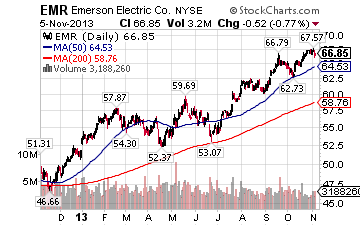 Emerson Electric Co. (NYSE: EMR), provides electrical engineering products and services. It has increased its dividend every year since 1957. Its yield is 2.9% and its P/E is 20.4 times. The company's dividend has increased 4.6 times since 1993 and its return on equity is 20.1%. Again, a top quality Heirloom Stock, albeit a little expensive at the moment.
Emerson Electric Co. (NYSE: EMR), provides electrical engineering products and services. It has increased its dividend every year since 1957. Its yield is 2.9% and its P/E is 20.4 times. The company's dividend has increased 4.6 times since 1993 and its return on equity is 20.1%. Again, a top quality Heirloom Stock, albeit a little expensive at the moment.
 3M Company (NYSE: MMM) has increased its dividend every year since 1959. It has a yield of 2.5%, and a P/E of 16.4 times. It has enjoyed a less exciting 2.9 times dividend increase since 1993 but the consumer price index is up only 62% in that period. However, its return on equity is a stellar 26.6%. It may not be rapidly growing, but still makes for an excellent long-term investment.
3M Company (NYSE: MMM) has increased its dividend every year since 1959. It has a yield of 2.5%, and a P/E of 16.4 times. It has enjoyed a less exciting 2.9 times dividend increase since 1993 but the consumer price index is up only 62% in that period. However, its return on equity is a stellar 26.6%. It may not be rapidly growing, but still makes for an excellent long-term investment.
The Best New Dividend Stocks of 2013
Thanks to this year's booming market for initial public offerings (IPOs), there are a handful of new dividend stocks for yield-starved investors.
In the first quarter of 2013, 45% of all new offerings paid a dividend. That compares to just 16% in Q1 of 2012, according to data from Renaissance Capital.
This is the most dividend stocks to debut in a quarter since Q2 of 2008, when 69% of IPOs paid a dividend.
The trend is in direct response to investors' hunt for yield, and comes at a time when dividend stocks should be part of everyone's portfolio.
A Standout Among MLPs
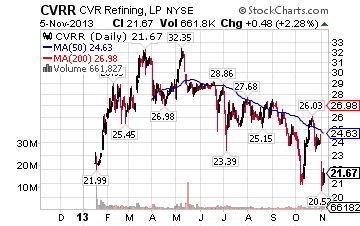 Among the 14 dividend paying IPOs of Q1 2013, 10 were master limited partnerships (MLPs) and real estate investment trust (REITs). Both are a special class of equities coveted for their handsome payouts and yield.
Among the 14 dividend paying IPOs of Q1 2013, 10 were master limited partnerships (MLPs) and real estate investment trust (REITs). Both are a special class of equities coveted for their handsome payouts and yield.
A standout in the MLP initial public offering category is CVR Refining LLP (NYSE: CVRR), up 40% since its Jan. 16 entrance at $25. Renowned activist investor Carl Icahn owns 71.2 million shares of its parent firm CVR Energy Inc. (CVI) which still maintains an 80% plus stake in CVRR. CVI is the second-largest position in Icahn's portfolio.
Sugar Land, TX-based CVRR, a petroleum refiner, is attractive based on its flush cash flow, robust earnings and distribution guidance. It trades at five-times earnings and operating cash flow has grown 500% over the last two fiscal years. Shares have a forward yield upwards of 20%.
The Rewarding REIT
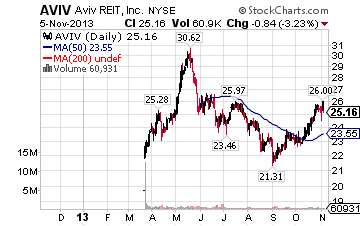 To date, real estate and property offering are up almost 40% from last year to nearly $14 billion. Healthcare offerings have jumped to nearly $10 billion from less than $7 billion in 2012.
To date, real estate and property offering are up almost 40% from last year to nearly $14 billion. Healthcare offerings have jumped to nearly $10 billion from less than $7 billion in 2012.
In this combined category is Aviv REIT Inc. (NYSE: AVIV). Shares hit the Big Board March 20 at $20 a share. The stock popped 14% on its first day of trading and is up 20% in just a few months.
Aviv REIT owns post-acute, long-term care skilled nursing facilities and other healthcare properties. The company owns 258 properties that are leased to 38 operators in 29 states.
Aviv's payout rate is among the highest in the sector at 7.6%
Nothing Like a Classic
 Pinnacle Foods Inc. (NYSE: PF) is the company behind the classic Vlasic pickles, Swanson Pot Pies and Mrs. Butterworth's pancakes. PF went public March 27 at $20 a share. Shares have since climbed more than 17%.
Pinnacle Foods Inc. (NYSE: PF) is the company behind the classic Vlasic pickles, Swanson Pot Pies and Mrs. Butterworth's pancakes. PF went public March 27 at $20 a share. Shares have since climbed more than 17%.
Pinnacle boasts a hearty 3.8% annual yield (based on its target quarterly dividend of 18 cents). That handout is well above the average 2.2% dividend yield of stocks in Standard & Poor's 500 Index.
CEO Bob Gamgort told CNBC, "Our dividend payment is reflective of the incredible free cash flow we have. We can pay a 3.8% dividend yield and yet have a tremendous amount of cash flow to invest in the company, to pay down debt, and to pursue M&A."
The Buffett Rules
Finally, let's look at some fantastic principles to follow in any market conditions. They are Warren Buffett's investing rules.
After all, the Oracle of Omaha hasn't earned his nickname by mistake. To many, it seems the billionaire has a sixth sense when it comes to investing, a supernatural ability to divine the good investments from bad.
But while his ability may be uncanny, there's really no magic at work. What Buffett has above all else is discipline. His philosophy is based on patience.
As a value investor, Buffett's goal is to identify companies the market has undervalued or companies that are trading cheaply compared to their intrinsic value.
Once he finds them, he buys them and holds on to them for the long term while their value steadily increases over decades.
Beyond those simple tenets, there are a few rules - those other Buffett Rules - that guide Buffett's conscience as he makes investment decisions.
Rule No. 1: Consistent Performance
Warren Buffett won't even consider a company unless it's been around for 10 years or more and can demonstrate a record of consistent performance.
One metric Buffett uses to track performance is return on equity (ROE). ROE measures the rate of return on the money invested by stockholders and retained by the company in profitable times, demonstrating a company's ability to generate profits from shareholders' equity (net assets). In other words, ROE shows how well a company uses investment funds to generate growth.
 Last November, after years of eschewing technology stocks, Buffett sank $10.7 billion into International Business Machines Corp. (NYSE: IBM). A quick look at IBM's ROE tells much of the story. With a stellar 73.40% ROE, IBM is in the 98th percentile overall, and the single-best performer in its industry.
Last November, after years of eschewing technology stocks, Buffett sank $10.7 billion into International Business Machines Corp. (NYSE: IBM). A quick look at IBM's ROE tells much of the story. With a stellar 73.40% ROE, IBM is in the 98th percentile overall, and the single-best performer in its industry.
 The Coca-Cola Co. (NYSE: KO), another of Buffett's holdings (he owns 200 million shares), has a less astronomical - yet still very impressive - ROE of 26.18%
The Coca-Cola Co. (NYSE: KO), another of Buffett's holdings (he owns 200 million shares), has a less astronomical - yet still very impressive - ROE of 26.18%
Rule No. 2: High Income
Buffett has said that one of the best ways to stay wealthy is to invest in companies with a stable business and a high dividend. As a buy-and-hold investor, Buffett minimizes his tax liability by remaining in his positions for years, even decades.
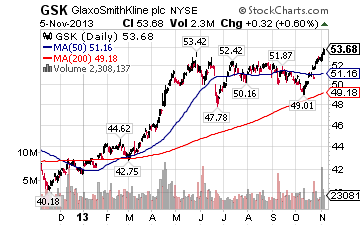 Dividend stocks help to balance out a growth-oriented portfolio, which is what you'll have if you're following Buffett's footsteps. Your portfolio will be more diverse, and you'll be insulated a bit from market volatility.
Dividend stocks help to balance out a growth-oriented portfolio, which is what you'll have if you're following Buffett's footsteps. Your portfolio will be more diverse, and you'll be insulated a bit from market volatility.
 In Buffett's portfolio, you'll find high-yield stocks like General Electric Co. (NYSE: GE), which yields 3.60%, and GlaxoSmithKline plc (NYSE: GSK), which pulls in 5.80%. You'll also find ConocoPhillips (NYSE: COP), in which Buffett has $2.1 billion invested. COP has a market cap of $96.8 billion and is yielding 3.60%.
In Buffett's portfolio, you'll find high-yield stocks like General Electric Co. (NYSE: GE), which yields 3.60%, and GlaxoSmithKline plc (NYSE: GSK), which pulls in 5.80%. You'll also find ConocoPhillips (NYSE: COP), in which Buffett has $2.1 billion invested. COP has a market cap of $96.8 billion and is yielding 3.60%.
The important thing to look for is dividend growth. As the company grows and the stock price goes up, does the dividend rise? Look for companies that have increased their dividend each of the last several years.
Rule No. 3: Manageable Long-Term Debt
 Warren Buffett, as a general rule, doesn't like debt -- especially long-term debt. The debt-to-equity (D/E) ratio tells investors what proportion of equity and debt the company is using to finance its assets. A high D/E ratio can lead to greater volatility in a company's earnings. But what's really important is how much debt a company has compared to its competition in the same industry. All of Buffett's positions take a prudent approach to debt.
Warren Buffett, as a general rule, doesn't like debt -- especially long-term debt. The debt-to-equity (D/E) ratio tells investors what proportion of equity and debt the company is using to finance its assets. A high D/E ratio can lead to greater volatility in a company's earnings. But what's really important is how much debt a company has compared to its competition in the same industry. All of Buffett's positions take a prudent approach to debt.
Take, for example Johnson & Johnson (NYSE: JNJ). Its D/E ratio currently sits at 0.3439, which is about average. But over the last five years, it's 0.2648, a bit better than average.
 Intel Corp. (Nasdaq: INTC), another of Buffett's newer holdings, has averaged a D/E of 0.064 over the past five years. Visa Inc. (NYSE: V), in which Buffett has a nearly $100 million stake, has had a microscopic D/E ratio of 0.030 over that same period.
Intel Corp. (Nasdaq: INTC), another of Buffett's newer holdings, has averaged a D/E of 0.064 over the past five years. Visa Inc. (NYSE: V), in which Buffett has a nearly $100 million stake, has had a microscopic D/E ratio of 0.030 over that same period.
While he only speaks about debt in a general sense, it is believed that Buffett is most concerned with a company's ability to repay its debts. To figure this out, simply divide the long-term debt by profit. In the case of JNJ, it would take just a bit over three months for it to pay off its long-term debt, which is very manageable.
Rule No. 4: The "Economic Moat"
High profit margins relative to a company's closest competition are extremely important. This creates what is known as an "economic moat," a term coined by Buffett to describe a company's competitive advantage. Economic moats help defend against competitors that try to gain market share by imitating successful products. In short, an industry leader itself can be an imposing barrier to entry, and those are companies Buffett thinks have value.
 Look at Procter & Gamble (NYSE: PG), owner of brands like Tide, Pampers, Oral-B, Gillette, and Duracel, to name just a few. PG's long-term strategy is to compete only in markets where it is first or second in market share. That leadership position allows the company to comfortably raise prices when its costs go up, and its many popular brands represent pretty high barriers to entry in most of the markets in which they compete.
Look at Procter & Gamble (NYSE: PG), owner of brands like Tide, Pampers, Oral-B, Gillette, and Duracel, to name just a few. PG's long-term strategy is to compete only in markets where it is first or second in market share. That leadership position allows the company to comfortably raise prices when its costs go up, and its many popular brands represent pretty high barriers to entry in most of the markets in which they compete.
Rule No. 5: Sound Management
Buffett has said that investors should buy stocks as though they are buying the company. Buying stocks, therefore, is a vote of confidence in how that company is managed.
Evidence of good management, in Buffett's view, is when management's actions deliberately benefit shareholders. This includes things like share buybacks, wise use of retained earnings (transforming earnings into market value), and focusing on the core business. In general, it's when management acts as a good shepherd for its shareholders' money.
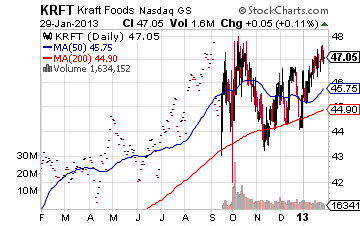 Berkshire's holdings read like a who's who of well-managed companies: Kraft Foods Inc. (NYSE: KFT), Wal-Mart Stores Inc. (NYSE: WMT), M&T Bank Corp. (NYSE: MTB), Sanofi SA (NYSE: SNY), and U.S. Bancorp (NYSE: USB), to name a few.
Berkshire's holdings read like a who's who of well-managed companies: Kraft Foods Inc. (NYSE: KFT), Wal-Mart Stores Inc. (NYSE: WMT), M&T Bank Corp. (NYSE: MTB), Sanofi SA (NYSE: SNY), and U.S. Bancorp (NYSE: USB), to name a few.
So there's no magic or extraordinary clairvoyance illuminating Buffett's great investments. There's not even a complicated trading strategy at work.
It is just a simple, principled approach to investing that's made Warren Buffett a billionaire several times over.
BONUS: The 7 Deadly Sins of Trading
![]()
There is no room for any fear in trading. Caution, yes. Respect of the market, yes. Fear, no, and it comes in many shapes and forms:
- Fear of losing money.
- Fear of making a wrong decision.
- Fear of missing a stock that runs.
- Fear of selling too soon if you have a profit.
 How do we, as traders, address these emotions? Let's take them one at a time.
How do we, as traders, address these emotions? Let's take them one at a time.
Fear of losing money: First, we have accepted the fact that we will have losing trades before we ever entered the market. Second, we’ve assessed the trade before we entered a position. We know our loss limit, and we stick with it. Third, since we’re scaling into our position, we actually want the stock to go lower much of the time so that we can get our full position at the lowest possible cost basis. Finally, we have limited the amount of capital we ever invest in one stock, so even if that stock goes to 0, it doesn’t wipe us out.
Fear of making a wrong decision: That is why we establish parameters for each and every trade before we ever enter a position, and we follow the parameters for that trade. This is also why we evaluate a stock both technically and fundamentally, to reinforce our decision to trade this stock. Before we enter the position, we determine that this is a good decision, and we know our loss limit. Remember, trading can never be 100% accurate. Many traders have more losing trades than winning trades, but they limit their losses on the losers, and hold the winners for much larger percentage gains.
Fear of missing a stock that runs: We'll say it right now, you will miss some. You can't possibly play every stock out there. Be happy for those that are in the runners, and know that you will have your share of winners. A trading friend often says, "once in a lifetime opportunities occur five times a day." Scaled buying helps us get in a position even if there’s more downside, and we feel like "at least we're in if it does run." The last thing you want to do is start chasing stocks, which is emotional, undisciplined trading. Don't get caught in the mindset of "all the stocks are running but mine." There are many opportunities daily in the markets, and it's impossible to play them all.
Fear of selling too soon: That is exactly why we use scaled exits, locking the smaller profit to let the remaining portion ride for the bigger gain. And NEVER regret a profit, regardless of what the stock does after you exit. Profit is what trading is all about. We will happily take consistent 20% gainers as opposed to one 100% gain but ten 10% losses.
"Excellent presentation of some complicated and involved information transformed into an easy to read and digest format." – Gary Quigley, Wisconsin |
||
![]()
The absolute worst form of fear, the one that will cost you every single time you let it dictate your trading, is panic. If you ever feel panic, step away from the screen, collect your thoughts and don’t dare make a trade until the emotion passes. There is always the possibility of horrendous news after trading hours and a huge gap down that bypasses your stop, but if we’ve done our due diligence carefully, we shouldn’t be in that situation. None the less, it is always possible in the market, but reacting with panic will usually cost you money. Step away, let the emotion pass, and formulate a new plan before dealing with the situation.
We often say that we profit from the fear of others. Losing sight of the trading plan and underlying fundamentals causes fear, an emotion, to dictate the trade, and emotions should never enter the trading process. When your palms are sweating and you think "I simply can't hold this stock any longer", that's typically the time to buy more.
![]()
The flipside of fear is greed. When you let greed take over your trading, you will break rules, get sloppy, and eventually lose money. Guaranteed. Never let a winning trade turn into a losing trade. When you have a 20% gain or more, always sell one half of your position. When you have a 40% gain, always sell one half of your remaining position. This doesn’t mean we are always waiting for a 20% gain on a trade, many may be less. But we will always take off half with a 20% gain.
Here is a specific example:
For a stock we traded last year, we accumulated a position at a 5.20 average. We sold our first half at 6.50, a quarter at 7.25, and stopped out of our remaining quarter at 6.80. Others were screaming the stock would go to 10.00. Greed and crowd hysteria was controlling their trading. The stock eventually retraced to 5.50, warned, and opened the next day at 4.00. Had we let greed dictate the trade as opposed to our pre-established parameters, we would have turned a nice gain into a loss.
![]()
Forget being stubborn in the stock market. If you’re going to be stubborn, you might as well give all your investment funds to a charity now, or put it all in a long term bond. The market is smarter than you, the market is faster than you, and the market has more liquidity than you. One of the main reasons people lose money in the stock market is they refuse to admit it was a bad decision to buy a certain stock at a certain price, and they ride it down and down and down. It goes simply goes against human nature to say "I was wrong." You are programmed to believe that your decisions are good. In the market, you will never be 100% right. You have to accept that. You have to accept losses. Until you can accept the simple fact that you will lose money on some trades and, more importantly, learn from those losing trades, you will never have success in the market. Never beat yourself up over a losing trade. Learn from it.
"Love it! Well-written and simple for a new trader like me to understand. Thank you. You helped me immensely." – Ana Miller, Texas |
||
If a trade is moving quickly against you, don't lower your stop because you’re convinced the stock will eventually go higher. Keep your stop in place, and re-enter lower if you stop out but still believe the stock has merit. If a trade is taking too long to develop, meaning you entered with a short term target but you’ve now held for two weeks and the stock has gone nowhere, exit the trade. That was short term capital, and if you were expecting a short term bounce and didn’t get it, chances are now 50/50 that the stock will go lower. That is one of the parameters you set for the trade when you entered it: the duration you were willing to hold the stock. Don’t change that parameter due to stubbornness. The only reason to redefine the duration as set by your trade parameters is if a forward looking event has been announced that makes it worth holding longer. Otherwise, regardless of what the stock does after, if the trade hasn’t developed, don’t be stubborn. Exit and move to the next.
![]()
The opposite of being stubborn in the market is indecision, another emotion that has no place in the market. Time for another old market saying: "when in doubt, stay out." The markets, and certainly the stocks in them, can move very fast. Indecision has no place in the market and will cost you money every time. If you decide to enter a trade quickly on breaking news, take a few minutes to at least generate a trading plan, quickly look at a chart to know support and resistance levels, and formulate a basic entry, exit and stop strategy. A few minutes formulating a plan may cost you a few pennies on the entry, but will help you profit and protect capital in the long run.
Let me give you an example:
We entered a trade on a news release. We were somewhat indecisive as to whether the news would move the stock higher, but jumped in anyway. When the stock didn’t move up right away, we checked other recent news. It turned out it was the finalization of a contract previously announced, and was already priced into the stock. We entered without a plan, without checking a few facts first, without checking the charts, and exited at a small loss when the stock "sold the news." In this instance, we couldn’t decide if the stock would just run away from us quickly, so we leaped in. Indecision caused impulsive trading that resulted in a loss.Another time, we were in a stock that released a negative decision from the FDA on a medical device. Without hesitation, we sold the stock at a small loss. The stock went on to lose 50% of its value during the course of the day. We knew that this was a possibility when we bought the stock, and so our decision was made quickly and easily. We already had our plan in place, and that allowed us to make a quick, informed decision, not an emotional one.
"Thank you so much for a superbly excellent report which I will save to study. I appreciate that you don't require a paid subscription to look at this report. I will definitely be subscribing to any other newsletters you have." – Lars Aspenlind, California |
||
![]()
Trading and investment decisions should be based on fundamental research and technical analysis, not hope. Successful SwingTrading is based on calculated risk vs. reward, and hope does not enter this equation. If a stock is falling due to a technical breakdown or because it’s overvalued, hope will never bring the price back up. With the right stock and trading plan, hope should never enter the equation.
![]()
Everyone has a story. A sure bet. You know what I mean. You’re at a cocktail party and you overhear one of your neighbors talking about the newest whiz-bang gadget that’s going to change the world. Should you invest? The answer is… it depends.
Learn to recognize the signs that they may be controlling your trading decisions. The best traders and investors are calm and collected, they formulate trading strategies and they stick with their plans. The dangerous emotions must be left out of your equation to consistently profit in the market. This includes falling in love with the stock’s story or products—to the detriment of your investing decisions. Follow your research and your plan—and don’t allow yourself to be swept up in the romance of the company story.
You will have losing trades. You will have losing days. You will have losing weeks. You will have losing months. Accept those facts before you ever buy a stock. Repeat them over and over in your head and accept that losses are part of trading. You will also have winning trades. You will have winning days. You will have winning weeks. You will have winning months. You should also accept these facts. The point is to have more winners than losers, keep losing trades to minimal losses, and maximize profits on winning trades. Those are the mechanics of trading that come with experience, and by following a set of pre-designated trading rules. The single most important factor that can stand in your way of success in the stock market is your own emotions.
If you are emotional regarding your trades or if you let emotion dictate your trading decisions, you will never have success in the stock market. Period. Read that again and remember it.
BONUS: Ten Commandments of Trading
The 1st Commandment: Protect Your Capital
"Solid analysis - very clear presentation. Typical of most of your articles - excellent." – Donald Stirling, Canada |
||
Without capital, you have nothing to trade with. Trading stocks, by nature, has risk involved. You have to risk capital in order to return a profit. You will have losing trades along the way, there's absolutely no avoiding them.
We’d suggest that you abide by a simple rule: Never have more than 20% of your portfolio in one stock.
Minimizing your exposure in one stock guarantees that if bad news comes out, or a technical breakdown occurs, you won't lose too much of your trading capital. Losing trades are part of trading, but keeping those losses to a minimum is crucial to success in the market.
The 2nd Commandment: Trade with a Plan
It's a very simple market concept: Plan your trade, and trade your plan. Nothing about trading should be haphazard, impulsive, or random. Prior to entering any position, we always have a trading plan for that stock. The trading plan includes the following:
- Scaled entry levels on a cluster of support levels based on technical readings.
- Stop levels, both mental for intraday trading and physical for damage control in the event of bad news.
- Scaled exit points for profit at key resistance levels based on chart readings.
- An assessment of "value" based on examining fundamentals.
- The amount of portfolio value we're willing to invest in a particular stock.
- The duration we're willing to hold the stock, first determining if this is intended as a short term, medium term, or longer term trade.
- Any potential upcoming events that may affect the price of the stock.
The 3rd Commandment: Practice Patience, Before the Buy
You may have heard the saying that patience is rewarded in the stock market. For the long term investor, that implies buy a growth stock, and patiently hold your position. For SwingTrading, we believe the patience factor is most important before we place the buy order. You will often hear us say we are "patiently" waiting for a stock to reach our buy range, or "we patiently waited" until it hit our purchase price, and then entered. Having a trading plan for each stock is crucial, and that begins with patience, waiting for an entry that maximizes profit potential.
The 4th Commandment: Scale In, Scale Out
Unless we're entering a daytrade, it is very rare for us to enter a full position on a stock in one order. We believe in scaling into a position over several days, sometimes weeks, then scaling out. By scaling in and out, we mean two, three or four planned buys, then selling in halves or thirds.
SwingTrading is often finding significant bottoms in stocks. It is virtually impossible to find the exact bottom, so in developing our trading plan for a stock, we look for several entries at a cluster of support levels or trend lines. The end result is as low of a cost basis as possible. The second reason we like scaled entries is it helps avoid tying up too much money in one stock at one time. If you enter a full position in a stock at once, that capital is tied up for the duration of the trade. By scaling in, we reduce the amount of time the full amount of capital invested is tied up. The goal is to time the final entry as close as possible to the reversal.
Scaling out of a position also serves two purposes. By taking profit on a half or third of the position at the first resistance level, it allows us to hold the remaining position for a larger gain, while minimizing the risk of a losing trade. If on the first attempt, that resistance level is not broken, and the stock retraces, we have the flexibility to "flip" back into the stock with a full position, or simply keep the remaining original position for an eventual breakout above resistance. The second purpose of scaled exits is to free up trading capital for other opportunities, and begin the process over.
We are believers in consistent, short term profits, with occasional much larger gains. Scaled entries and exits helps us to enter at the lowest possible cost average, have an initial position if first support levels hold, achieve our goal of short term profit with a scaled exit on half, but also find larger gains by holding the remaining half comfortably. Scaled entries and exits are very closely tied to good portfolio management, as well as the trading plan we develop for every stock.
The 5th Commandment: Examine Technicals and Fundamentals
"Many of us read too many of these sites and are lulled to sleep by mostly the same material and mindset. Investors Alley has investing insights that identify where the current and probably future investing bonanzas are and could be. New world, new ideas - looks like Investors Alley has garnered the right sense of direction for these times!" – Don Griffiths, Illinois |
||
The general consensus among traders is that short term trading is based on technicals, while long term investing is based on fundamentals. We would generally agree with this assessment, but for SwingTrading, like to examine technicals AND fundamentals. There are times technicals supersede fundamentals in stock behavior, just as there are times fundamentals take over despite technical readings. We will daytrade or short term trade based purely on technicals, but it's very rare that we enter any position without examining both technicals and fundamentals.
The highest returns in the market are usually because technicals reach extreme readings which the underlying fundamentals don't support. When oversold readings reach an extreme despite fundamental value, the perfect opportunity is established for both a short term and longer term SwingTrade. The technical bounce allows us to capitalize on a short term trade with part of our position, while the fundamental value allows to hold a portion of the position for a longer term, higher return trade. By longer term, we mean several weeks or months.
When examining technicals, we are primarily looking for oversold conditions, or overbought, with three confirming indicators for a short term reversal. We may start building a position based on short term extremes, but like to see indicators shifting and confirming one another in the direction of our trade, which are technical divergences. We also look for clusters of support or resistance based on trend lines and historical price ranges. When examining fundamentals from the long side, we look for high cash or net tangible assets, low debt, and growth prospects. From the short side, we look for unsustainable valuation.
Most importantly, examining a combination of technicals and fundamentals helps to minimize losing trades. Chasing a stock up on a breakout when underlying fundamentals don't support the move often results in a quick reversal, with "stockholders" finding themselves at a loss. Although there's always a risk of bad news coming out on any stock, understanding the underlying technicals AND fundamentals can help us avoid these situations. Combining technicals and fundamentals will always increase the chances of a high return trade.
The 6th Commandment: Honor Targets and Stops
The purpose of trading is to make money. The best way to ensure that happens is to honor sell targets when they're reached. The 1st Commandment of trading is to protect your capital. The best way to ensure that happens is to use and honor stops. If we've established a trading plan for a stock, which we always do, then the only way to execute that plan is to honor the parameters for the trade that were established prior to initiating a position.
Our basic rule for stops, a starting guide, is to lose no more than 8% of the value of the capital we have invested in that stock. Another parameter is no more than 2% of total portfolio value. We look for clusters of support levels to establish price ranges for stops, and then calculate those with our loss limits. Although there are times we "bend" our rules, 95% of the time we will honor our original stops. If you get in the habit of lowering stops, you may find that your losses are rapidly becoming larger.
In general, the only reason to lower a stop would be new news or information that increases the chances of short term price appreciation. To so simply because of a "feeling" or stubbornness will almost always result in a larger loss than the original trading plan called for.
Equally important is to honor sell targets. Greed can quickly turn a winning trade into a losing trade. Regardless of what the price of the stock does after a target is reached, if a profit goal is met, then the trading plan has been successfully executed. Our general rule is to always sell half with a 20% gain. Many trading plans call for much lower percentages than 20%, but that's one rule we rarely break. If we've identified resistance levels, and our profit goals are reached, then we honor those sell targets and lock our profit. Selling in portions helps maintain a partial position if there's reason to believe the price will continue in the direction of our trade.. Successful trading requires maximizing gains, so one has to be willing to alter the plan, but at least a portion of the position should be sold when an initial target is met.
The 7th Commandment: Keep a Trading Journal
FREE 15-Day Trial to SwingTradeOnline
|
||
The market is a place that gives you a clean start everyday. It's also a place that always leaves room for improvement, and can quickly turn against you if you're doing something wrong. Trading can be streaky, so it's important to achieve consistency. We examine each and every trade we make, looking at what we did right, what we did wrong, what we could have done better, what we missed if the trade turned against us, then attempt to apply these lessons to future trades. The only way to make a true assessment of how you're trading is by keeping a thorough log of your market activity. The lessons learned, sometimes what we did well, sometimes what we did wrong, can then be applied to future trades.
Trading patterns, positive and negative, often repeat themselves. Some common ones are: buying too soon, selling too soon, giving back profit by not closing the trade, setting stops too loose or too tight, being too heavily invested in one sector, waiting too long to enter a position thus missing trades, being overly cautious, being in too many high risk trades that turn against you, and abandoning a trading plan. When negative patterns develop, and repeat themselves in losing trades, this can cause a lot of frustration and have a horrible effect on trading. When positive patterns repeat themselves, and consistent, high percentage, winning trades are being made, that can have a positive effect leading to a longer term winning streak. Being aware of these patterns and correcting them if needed is crucial. The best way to do that is by keeping a trading log, going back and examining each and every trade with your log with the chart, and recognizing patterns as they develop.
We keep a trading a log broken down by month. We also keep a separate research journal broken down by month, it should be noted, with a list of stocks we have on primary and secondary watch. We often look at a stock, but decide it might be better to revisit that stock at a later time, so we'll make that note in a future month. Each trader has to find a system that works for them, and you'll be amazed at what you'll discover about your own trading patterns if you don't currently keep a journal, but begin to do so.
At the end of every month, we take an hour and review all our trades for the prior month, looking at the charts we used to make our decisions. If we notice patterns, the stock goes up another 10% after our final exit, raised our trailing stop but got taken out with a small profit only to see the stock jump up, we're stopping out of too many positions at a small loss, and many, too many of our trades were all in the same sector limiting our diversity, and many more that reveal themselves, then we can make adjustments. We can also compare our overall performance to how the markets did, to get a sense of what we need to do differently in current market conditions. Without this journal, it's impossible to have an unbiased assessment of our trading.
It's important to note that all traders, at one time or another, will hit a losing streak. If that happens, we believe it's best to take a break from the market for a few days, then paper trade for a few weeks to regain confidence. It's then a good idea to re-enter the market with smaller positions until winning patterns are re-established. Having a journal can be a tremendous help in making the needed adjustments if this happens.
The 8th Commandment: Don't Force Trades
Or another way of putting it, let the trade come to you. One of the hardest parts of trading is sitting on your hands and doing nothing. The majority of full time traders, according to many research sources, spend more time on the sidelines than they do in positions. We know a trader who makes, on average, 3 trades per week. They are very well calculated and timed trades that return high percentage gains. We know another trader who is a scalper, in and out of 10 to 12 trades a day, usually no more than 15 minutes in duration, all based on intraday pivot points. Although different in their styles, they both have one thing in common. They let the trade come to them.
Love this special report? Hate it? We want to hear from you! Tell us what you think of this report and what you'd like to see on Investors Alley in the future. Click here to email us your comments and feedback.
In the case of SwingTrading, forcing trades may mean entering a stock too soon, prior to chart confirmation, or well before the parameters established for the trade, due to the feeling of "needing to be doing something". It may mean chasing stocks up if several entries are narrowly missed, only to see the trade turn against you if a buy is made in no man's land, half way between support and resistance. It may mean buying a stock that is simply dead money and has no impetus for a price rise, again out of that feeling of needing to make a trade. There are times when it is simply best to sit on the sidelines, and wait for the best opportunities. If you feel you're missing too many trades, then it may be time to re-examine the trading parameters, and starting positions with smaller entries sooner to at least have a position.
Forcing trades may also mean selling too soon over and over, not maximizing profits. As SwingTraders, we sometimes spend several days or even weeks accumulating positions without ever closing a trade. As our targets are gradually hit, we can lock profits, and suddenly recognize a very nice percentage return over that period of time. We try to avoid feeling the pressure of making sure we take some profit every day or every week. Leaving money on the table on too many trades may actually mean less overall profit than a lot of small profits locked.
If you've established a trading plan for a stock, then let the trade come to you. Never force your way in. If you miss a few, well, there are 10,000 stocks out there, so plenty of opportunities. There are times you may need to make adjustments, and there are times you have to accept the fact you've missed a run. Forcing trades, however, can lead to sloppy trading, which will usually end up in losses.
The 9th Commandment: Control Emotions
The most difficult part of trading is eliminating emotions from the process. The most successful traders are calm, analytical, and methodical. If you let emotions dictate your trades, you will lose money. Period. Trading is basically calculating risk vs. reward based on a combination of technical and fundamental analysis. There is no room for emotions in that equation. The most common emotions that interfere with the process are fear, greed, indecision, stubbornness, and hope. Your mental will must overcome these emotions to be successful in trading.
The 10th Commandment: Trade with Discipline
"Great articles! Explains things clearly, simply, and even gives a chart showing more details. More significantly, you present guidance on when particular strategies may NOT be effective. I find your articles to be very clearly written, simple without being over-simplified, and useful for readers of all levels." – Motti Davidsohn, Maryland |
||
There are many styles of trading. SwingTrading, breakout trading, intraday pivot trading, momentum trading, and the list goes on. The one unifying factor among
successful traders, regardless of their style, is disciplined trading. Trading means taking calculated risks, and the only way to consistently profit from this is through practicing discipline.
Disciplined trading, in the case of SwingTrading, basically means obeying the first nine commandments. SwingTrading is a specific methodology of identifying key support levels, confirming there are technical and fundamental reasons to trade a stock, accumulating positions through scaled buys at support levels, using stops to protect positions, limiting the amount of investment in any one stock to protect capital, identifying sell targets, and exiting when targets are reached. Disciplined trading simply means executing the trading plan for each stock within the overall trading strategy, and doing so without an emotional response to the reasons for entering the trade, or the outcome of the trade. Without discipline, the methodology is disrupted, and sloppy trading will lead to losses.
All traders establish rules for their trading. Undisciplined trading occurs when those rules are broken. Any successful trader will tell you that their performance is negatively affected when they break their rules and ignore discipline. The most difficult part of trading is exercising discipline and mental will over emotions, but when accomplished, will result in consistent, positive performance. Plan the trade and trade the plan. The discipline is quite simple and will result in positive results…
One final note. There is an 11th commandment, which we hesitate to mention since it violates several of the others. HAVE FUN. If you're not having fun trading, then let someone else do it for you. The point is to make money and, quite obviously, that's most of the fun. But the entire process should be enjoyable, even the losing trades, because you can learn from them and profit in the future. We are fond of saying, we are as emotionless about trading as you'll ever find, but we are PASSIONATE about the markets. Have fun doing it, never beat yourself up over a loser, maintain the other ten commandments, and the 11th will take care of itself.
Sign Up for a Free 15-Day Trial
to SwingTradeOnline
SwingTradeOnline is dedicated to providing institutional-quality technical analysis of stocks and indices for traders with a several day to several week time horizon.
Led by former columnist for TheStreet.com, Jack Steiman is renowned for calling major shifts in the market, including the market top in October 2007.
In fact, Jack’s trading service SwingTradeOnline had 94 winning stock trades out of 145 in 2010, with a total return (sum of trades) of 171%.
For a limited time we’re making SwingTradeOnline available FREE, with a 15-day trial.
You’ll have 100% access to the full service, including:
» Jack's Intraday Journal - market alerts posted live on our Web site and also delivered by email featuring swing trades, stocks to watch, and technical market timing. Jack's call of the market top in October 2007 enabled followers to avoid steep losses and actually profit on his short picks, while he was 100% cash going into late 2008's market crash. His call of the bottom in March 2009 preceded a run of 30+ consecutive winning trades!
» Chat Room and NEW Live Audio-Video Chart Presentations - The Chat Room is a live forum for interacting with Jack and other members. The new Audio-Video feature is a pop-up window for hearing and viewing Jack as he discusses charts and answers member questions live periodically during the session.
» Swing Trade Scoreboard - table of Jack's portfolio holdings, including stops and targets, with intraday pricing and performance history of closed positions. Jack had 94 winning stock trades out of 145 in 2010, with an annualized return per position of +90.46%!
» Portfolio Chart Analysis - daily technical chart analysis on current and prospective positions, with annotated commentary on patterns and short-term direction.
» Ask Jack - message board of your questions and Jack's responses, providing timely answers and an archive of Q&A's from which to learn.
» Jack's Wrap - nightly technical market analysis posted both to this page and delivered by email that provides both a review of the day's session and a look ahead, and includes a number of index charts illustrating the market's developing patterns.
There's absolutely no risk with this 15-day free trial offer.
Join Today!


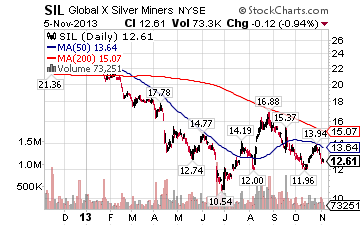 2 Silver ETFs to Buy
2 Silver ETFs to Buy
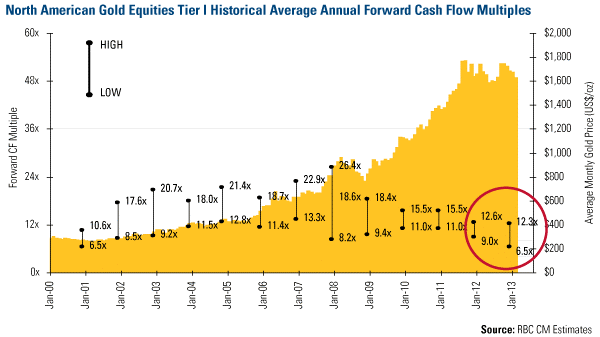
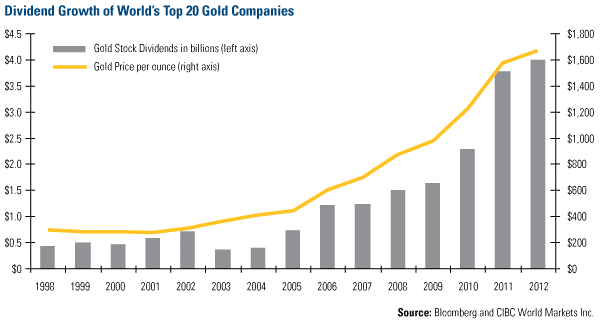
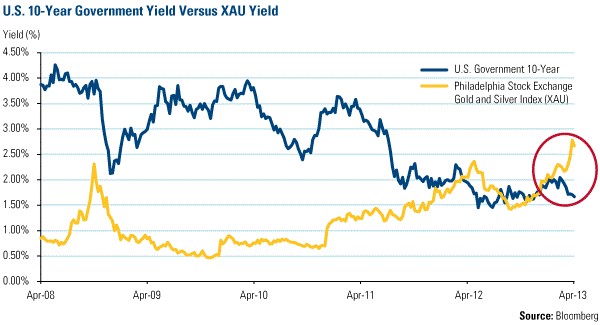
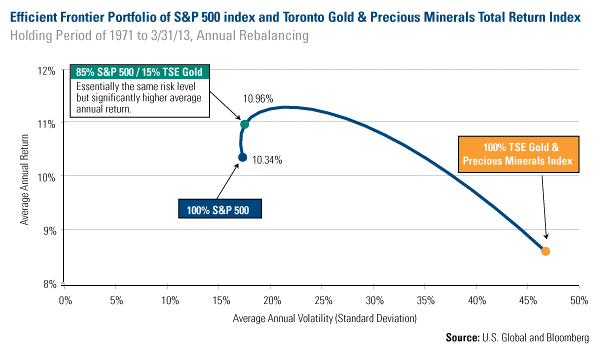
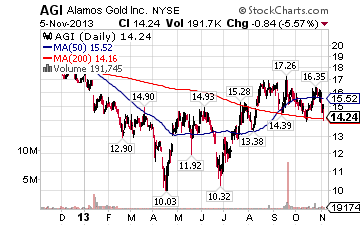 Not all miners are worthy of your investment, and the task of picking quality gold company candidates isn't simple. One company we currently like is Alamos Gold (NYSE: AGI), which reported first-quarter 2013 results last week.
Not all miners are worthy of your investment, and the task of picking quality gold company candidates isn't simple. One company we currently like is Alamos Gold (NYSE: AGI), which reported first-quarter 2013 results last week.